HOTEL FOOD & DRINK
 LEGACY – THE GRAND YORK • PACO RONCERO • DA VITTORIO – THE REVERIE SAIGON
LEGACY – THE GRAND YORK • PACO RONCERO • DA VITTORIO – THE REVERIE SAIGON




003 CONTENTS ISSUE 30 STARTERS The Hudson Rooms 042 Capella Hanoi Velvet 044 Corinthia London The Vasper 046 Mondrian Park Avenue New York 088 044 MAIN COURSES Legacy 049 The Grand York Da Vittorio 054 The Reverie Saigon Ho Chi Minh City Terre 062 Castlemartyr Resort Cork Mural Farmhouse 068 WunderLocke Munich © Edmund Dabney © Cristian Barnett © Alex Upton 068
SERVICE
Chef’s Table 026
Chef-restauranteur Wolfgang Puck, who helms a multitude of eateries around the world, shares his favourite food memories.
The Rules Do Not Apply 028
Spanish chef Paco Roncero opens up about creativity, pushing boundaries and running the most expensive restaurant in the world.
No Limits 034
As one of Italy’s most successful chefs, Enrico Bartolini is famed for a creative cuisine that honours tradition, seasonality and ritual.
Striking the Balance 040
Kate Brooke-Green, Head of Food at hip hoteldiner concept Mollie’s, discusses fostering passion and keeping things simple in the kitchen.


DINING
Ancestral Fruit 076 In Portugal’s wild heartlands of Alentejo, São Lourenço do Barrocal is honouring its heritage by taking olive oil production to new heights.
SIPPING

004 CONTENTS ISSUE 30
bartenders
beverage
Entrée 017 Appetisers 021 Signatures 084 Cocktails 094 Drinks 098 Events 100 Petits Fours 107 Washing-Up 122 REGULARS © Sanda Pagaimo
076
Decency and Decadence 088 Award-winning
Leo Robitschek and Liana Oster discuss transplanting their innovative
philosophies from New York to London via NoMad’s newest watering hole.
104 040


FESTA www.costanovaprofessional.com




Atelier by

WWW.STEELITE.COM SHOWROOMS AVAILABLE BY APPOINTMENT • ATLANTA • CHICAGO • HONG KONG • LOS ANGELES • LONDON, UK • MADRID • NEW YORK • SYDNEY, AUS • TORONTO • WASHINGTON, D.C. • YOUNGSTOWN, OHIO Visit us at Ambiente, Frankfurt from 3rd - 7th February 2023, Hall 11 | Stand C51

HERE NOW FOR CHANGE
Re-Gen series coming to life through the recycling processes of porcelain shards.

Since 2005, to offset our carbon footprint, recycled production fallouts has been greatsuccess. In 2022, R&D has taken another leap forward to complete ‘no production waste’. Tons of production broken pieces of kilned porcelain, misfits, non-standard choices are now being recycled back in, to become the Porland Re-Gen products.
Ambiente Frankfurt 03.02.2023 - 07.02.2023
Prestige Hall 12.1 - C20 Horeca Hall 11.0 - D11
porlandgastro





Mid-Century Modern www.myglassstudio.com Sleek Canape Display For Cocktail Parties
IT’S ALL ABOUT THE MOMENT
when your coffee makes your guests feel at home.
There is nothing better than waking up with a delicious coffee after a good night’s sleep. Our fully automatic coffee machines are easy to use, even as a self-service station for your guests. They deliver consistently high in-cup quality, so your guests can enjoy the perfect coffee experience to complement their pleasant stay. Because the better the coffee tastes, the more you will make your guests feel at home.

Discover more at coffee.franke.com


“WE DELIVER STELLAR EXPERIENCES”
 Stylelights by WMF Germany
Stylelights by WMF Germany
STELLAR BRANDS • STELLAR TEAM • STELLAR SERVICE A dynamic company with ideas that sparkle to light up your project like a supernova!
ENTRÉE
Purpose and Perspective
Why does hospitality matter? As we turn the corner into 2023 against an unsettling backdrop of ongoing international labour, supply chain and inflation issues, it could be the million-dollar question: how can F&B businesses woo cash-strapped consumers and stoke a desire to continue to eat, drink and be merry into the new year?
According to data and insight consultancy CGA’s Cost of Living Consumer Pulse, 45% of people consider eating out a ‘fundamental activity’ and around 64% of UK adults claim they would find it hard to put a stop to it, regardless of a looming threat of recession. Despite that positive starting point, foodservice wholesaler Bidfood’s 2023 Food & Drink Trends Report recently found that 53% of people are preparing to eat out less than before as financial strife deepens, and 48% are cutting back on going out for drinks. Clearly F&B venues will have to remain creative when it comes to enticing custom if they are to prosper in what is shaping up to be another sticky chapter for the industry.
Engagement, it seems, is key: research by Hilton recently found that 84% of its customers hope to travel as much, if not more, than the last 12 months over the year ahead – and, crucially, they expect to gravitate towards ‘engaging and diverse experiences and events’. Luckily, it’s a trend that lends itself deftly to the domain of hotel F&B, where exclusive culinary packages, often featuring a destination-specific aspect, are rising in popularity all over the world. Our trend report on page 24 explores the ways in which hotel groups are harnessing the power of their vast networks to develop location-sensitive activations for guests seeking gastronomic experiences with meaning.
And it isn’t just diners who are looking for a renewed sense of purpose. With staffing levels and recruitment currently a source of headaches for F&B businesses worldwide, attracting
– and retaining – talent has never been more essential to the success of the sector. In our interview with Kate BrookeGreen, Head of Food at the disruptive hotel-diner concept Mollie’s (page 40), the food development professional discusses her approach to nurturing talent creatively, driven by her passion to make hospitality roles an attractive career prospect to youngsters with a sense of purpose. The topic was also the subject of much debate at the recent edition of the top-tier industry forum To The Table Europe (read our report on page 102), where a panel of experts explored various strategies and initiatives geared at helping people unlock their passions and serve their principles via roles in the business. With policies ranging from profit-sharing programmes and wellbeing schemes to sustainable practices and free tattoos, the lively discussion underlined that there’s no one-sizefits-all solution to this dilemma, but that creative, adaptable thinking and an ability to help people find direction and progression within the industry remains crucial.
At Supper, our purpose has always been clear: we are here to celebrate and champion the dynamic global hotel F&B industry’s finest accomplishments. Once again, these pages are packed with ambition, offering deep dives into passion projects from Cork to Munich, via Hanoi, as well as interviews with eminent chefs Paco Roncero and Enrico Bartolini.

We are lucky enough to call this issue our 30th – thanks in no small part to the backing of the hospitality sector and those who find meaning in it. Thank you for your continued support, and Happy New Year. Supper is served.
Shanna McGoldrick • Deputy Editor
017
ON THE COVER Legacy, The Grand, York
EDITORIAL
Editor-in-Chief
Matt Turner m.turner@mondiale.co.uk
Managing Editor
Catherine Martin c.martin@mondiale.co.uk
Deputy Editor
Shanna McGoldrick s.mcgoldrick@mondiale.co.uk
Editorial Assistant Eleanor Howard e.howard@mondiale.co.uk
ADVERTISING
Advertising Manager
Rachel Chadwick r.chadwick@mondiale.co.uk
DESIGN Design Manager
David Bell d.bell@mondiale.co.uk
Production
Mel Capper m.capper@mondiale.co.uk
EVENTS & MARKETING
Commercial Lead Kirsty Studholme k.studholme@mondiale.co.uk
Content & Research Olivia Mavers o.mavers@mondiale.co.uk
Data & Marketing Lauren Blain l.blain@mondiale.co.uk
Subscriptions enquiry@sleeper.media
FINANCE
Finance Director

Amanda Giles a.giles@mondiale.co.uk
Group Financial Controller Sarah Healey s.healey@mondiale.co.uk
Group Credit Controller Lynette Levi l.levi@mondiale.co.uk
Accounts Assistant Kerry Mountney k.mountney@mondiale.co.uk
CORPORATE
Chairman
Damian Walsh
Annual subscription (4 issues): £72.00
Subscription records maintained at Sleeper Media Mailed by Spatial Global • Printed by Buxton Press
Strawberry Studios Stockport, SK1 3AZ, UK Tel: +44 (0)161 476 8390 www.sleepermagazine.com
@SupperMag
THE BRIGADE
POWERED BY
PORTFOLIO





Discover more at denbypottery.com/hospitality For further details please contact: TradeB2BAdmin@denby.co.uk Tel: 01773 740770 CREATED BY 20 PAIRS OF HANDS
APPETISERS
Developing Streetsense
Experience-focused strategy and design collective Streetsense has acquired Pure Grey, Marriott International’s in-house F&B concept and operations consultancy.
The consultancy works across all hospitality segments, including licensing its own restaurant brands internationally. Highprofile venues it has acquired include Revel & Rye at the New York Marriott Marquis, Laurel Brasserie & Bar at The Grand America Hotel, Spice Market at Live Aqua San Miguel de Allende in Mexico, and Market Kitchen at the vibrant new W Algarve in Portugal.
“Streetsense’s well-established eat and drink studio combined with Pure Grey’s operations and concept development capabilities will provide our clients the opportunity to imagine, create, build and operate leading hospitality and hospitalityled food and beverage brands and places worldwide,” says Streetsense CEO Brian Taff.

“Streetsense is a long-term collaborator with deep knowledge of Marriott’s 30 hotel brands, our food and beverage operations and our mission to deliver exceptionally well-executed experiences that resonate with guests and our hotel owners,” adds Matthew Von Ertfelda, Senior Vice President, Global Operations, Marriott International. “We are thrilled for Streetsense to expand on Pure Grey’s expertise and continue to provide innovative food and beverage concepts and experiences to guests worldwide.”
The collective has also appointed Ed Viita, Pure Grey’s Senior Director, as its new Managing Director of Hospitality. Under Viita’s leadership, Pure Grey has become a leading hospitality, culinary and food and beverage consulting firm managing entire creative and operations teams. Viita has also developed independent restaurants, bars and hotels, including the world-renowned Artesian at The Langham, and was behind the relaunch of The Savoy.
Shaken and Stirred
Tucked away in the historic quarter of Palma de Mallorca, Can Bordoy Grand House & Garden is known for its artfully eclectic visual compilation of contemporary design pieces and intriguing European antiques, set against the backdrop of a 500-year-old manor house. So when owner Mikael Hall and architecture studio OHLAB came to selecting a minibar for the hotel’s 24 luxurious suites, it was clear that the average refrigerator tucked away in the corner just wouldn’t suffice.
Enter the Can Bordoy Bar (CB-Bar). A playful and interactive celebration of both form and function, the bespoke piece of furniture is able to transform seamlessly from minibar, fridge and snack storage space to extendable desk or cocktail bar. It features integrated lighting and an inbuilt Audio Pro sound system with a custom-designed aged brass button station that complements the hotel’s penchant for retro-tinged nostalgia with modern capabilities.
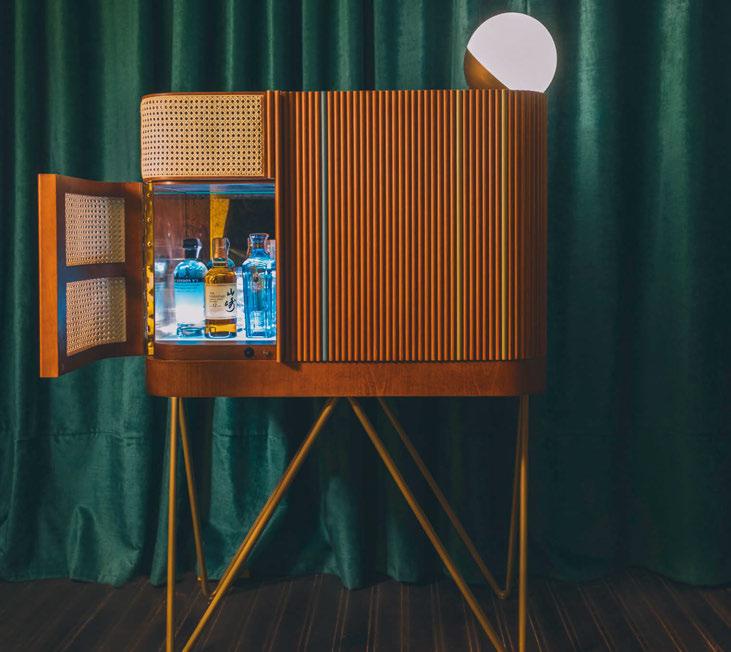
Though undeniably hardworking, the CB-Bar exudes an easy nonchalance thanks to a palette of plush materials such as velvet fabrics, solid walnut and brass finishes, which contrast with the walls of the rooms that are left deliberately unfinished. Inspired by the Bordoy family’s return to Mallorca after emigrating to the USA in the 1920s and again in the 50s, the minibar channels the sleek hairpin legs and grooved wooden panelling of the Mid-Century Modern period, coexisting with its surroundings.
Naturally, the bar comes equipped with all the necessary tools for guests to fix up a cocktail at whim; shakers, filters, stirring sticks and leather ice buckets are all housed neatly within. Premium wines and spirits such as Gramona Reserva Brut, Corpinnat, Monkey 47 Schwarzwald dry gin and Nikka Whisky from the barrel also come as standard, as do a variety of soft drinks and mixers. Chin chin.
Pedal Power
East London Liquor Company (ELLC) is putting the pedal to the metal in its mission to become more sustainable. Following the recent launch of its Project Refill closed-loop sustainability initiative, the spirits brand has partnered with e-courier logistics company Pedal Me to double down on carbon savings.
To mark the collaboration, in October Pedal Me took the liquor brand’s Booze & Beats Bike Bar on a 420km round trip to Amsterdam’s International Cargo Bike Festival, ferrying 165kg of ELLC booze out, and returning each empty bottle to its Bow Wharf distillery to be refilled and given away.
The feat, which resulted in a total carbon saving of 200kg, coincides with ELLC’s expansion of Project Refill via the launch of sales of its gin, vodka and rum in 10-litre jerry cans. Trade accounts can order spirits in the kerbside recyclable format so that existing bottles can be refilled for the back bar and speed rail, while off-trade sites can invite customers to provide their own empty bottles for refill on the shop floor.
“We didn’t start Project Refill just to pat ourselves on the back,” says ELLC Founder Alex Wolpert. “It’s to share and grow to make it become as big a beast as we can. With every new account that signs up to the scheme, the more people are able to buy into the idea and the more powerful it can become.”

022 APPETISERS
© Courtesy of Can Bordoy
© Kevin Dutton
Since 1924, Eternum has been an internationally recognised player in the world of stainless steel cutlery for the hospitality, with a presence in over 70 countries. X15, designed by Louis de Limbourg, is the quintessence of our know-how. Visit us at Sirha 6H49 - Ambiente 12.1 D11 - Internorga B2.EG.320.
Eternum - Belgium since 1924 - www.eternum.com - export@eternum.com

Hotel groups are leveraging top-notch chef connections to feed a growing demand for culinary experiences.
Traditionally the most compelling and elusive of culinary figures, the celebrity chef is habitually viewed from a safe distance – often via a TV screen or the glossy pages of a cookbook. But times are changing, and when it comes to the high-profile people responsible for their food, discerning diners are increasingly hungry for a slice of the action.
Enter: the rise of culinary tourism. Immersive F&B journeys with big-name chefs are now par for the course across the global hospitality industry – but particularly within the hotel sector, where the notion of the one-off, the pop-up and the temporary residency seems to lend an element of intimacy to eating out that food-focused travellers crave. From BBQ lunches
Getting Involved
destination-focused packages across its global portfolio. “Looking foward, we anticipate that destination-focused culinary travel packages will continue to increase in popularity – whether it be celebrity chef culinary weekends like those at Waldorf Astoria Los Cabos Pedregal, which sold out within days, or experiences that reflect and complement the surrounding destination,” says Adam Crocini, Senior Vice President of Global Food & Beverage brands, Hilton. In addition to big-name chef activations, the group is leveraging its guest loyalty programme to encourage members to engage with local culinary culture – be that making fresh dim sum at Conrad Maldives Rangali Island or baking a Royal Praline cake at Hilton Kuala Lumpur.
to master classes, chefs are engaging with hotel guests more than ever before.

Recently, hotel behemoth Hilton’s 2023 Trends Report found that 84% of its customers hope to travel just as much, if not more, in this coming year than the last – and crucially, while travelling, they expect to gravitate towards “engaging and diverse experiences and events”. It’s a trend that the group is already catering to – particularly in the arena of F&B, where unique culinary packages have proven to be a hit over the past 12 months. These include celebrity chef weekends in resort destinations such as Mexico, where the Waldorf Astoria Los Cabos Pedregal recently hosted events with big names including Kim Alter, Nancy Silverton and barbecue legend Ronnie Killen, and the Conrad Algarve in Portugal, which saw seven of the region’s Michelin-starred chefs convene onsite in October to celebrate International Chef Day, led by Heinz Beck.
Hilton expects to build on the success of these initiatives in 2023, doubling down on
And the group isn’t alone in seeking to harness the power of immersive F&B events. Dorchester Collection’s Hotel Bel-Air runs a Visiting Chef series that regularly attracts top talent in the industry: for 2022, the initiative kicked off with an alfresco barbeque helmed by Wolfgang Puck, Francis Mallmann and Nancy Silverton, among others. Ace Hotel Kyoto is kickstarting 2023 with a residency by Noma chef René Redzepi, while Maldivian resort Soneva Fushi has garnered attention for the rotating line-up of culinary stars it welcomes to its fine dining zip-line restaurant, Flying Sauces.
The trend plays to the strengths of large hotel groups, whose diverse locations and vast networks facilitate tailoring bespoke, locationsensitive experiences for guests at an individual property level – and it’s a positive cycle. As Crocini confirms: “This increased demand has given our food and beverage team members the opportunity to flex their creative muscles and develop high-quality programmes.”
024






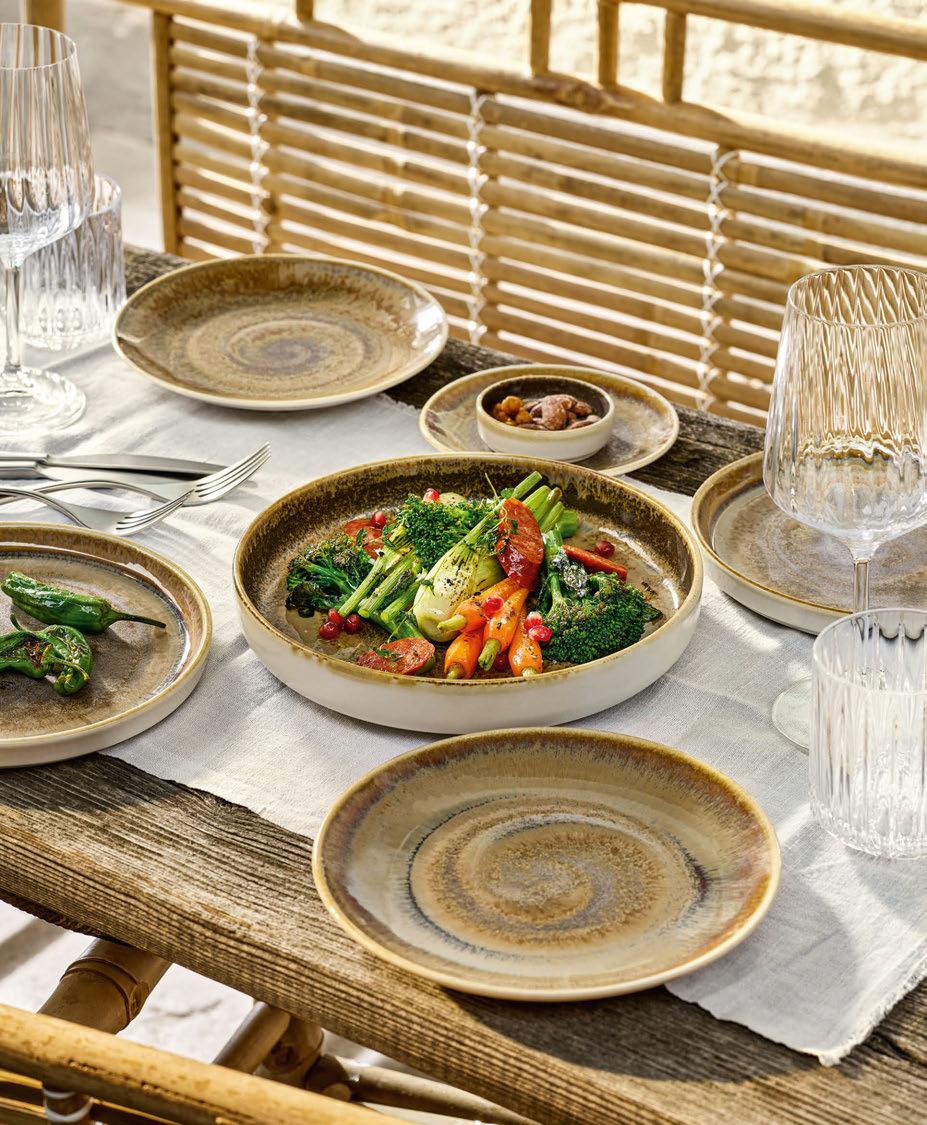






























new PerfectMatch _cumin www.heartandsoul.de BHS tabletop AG · THE TABLEWARE COMPANY
 © Marco Bollinger
© Marco Bollinger
Wolfgang Puck
The eminent chef-restaurateur, who helms a multitude of eateries around the world including LA dining spot Wolfgang Puck at Hotel Bel-Air, shares his favourite food memories.
When did you first fall in love with cooking?
For me, cooking was always a family affair. My mother was a very well-respected chef in Austria. I fell in love with cooking aged 12, when I was working in the pastry kitchen at the hotel where she was a chef.
What is your most memorable meal?
I’ve had many great meals in my lifetime, from Kyoto Kitcho in Japan to Le Moulin de Mougins by Roger Vergé in France, but my sentimental favourite is Baumanière. I was there over the summer with my family; we had the baby lamb with gratin de pinot and it was the best lamb I have ever tasted. Even my 15-year-old son Alexander agreed!
What’s your favourite dish and who cooks it?
My wife Gelila makes a delicious penne bolognese. It’s slightly spicy and with an extra helping of parmesan. She finishes the sauce with a sprig of rosemary too.
And something to drink with that?
When I eat Italian food, I tend to drink Italian wine, like a Barbaresco.
What’s your favourite hotel restaurant?
I love Hotel Bel-Air for the food, setting and ambiance; it’s very unique. I also really like Izumi at the Four Seasons in Geneva, especially in the summer; sitting out on the rooftop with delicious food and a gorgeous view from Lake Geneva to Mont Blanc.
Which chefs have inspired you?
The chef who has inspired me the most in my life is Raymond Thuilier; when I went to Baumanière, he immediately became my mentor. He was the first person who thought I had talent in cooking and always encouraged me to do my best.
How often do you dine out?
Since Wolfgang Puck Fine Dining Group has restaurants in LA, I seldom go to other restaurants, but I will sometimes go to Matsuhisa, Angelini or Osteria Mozza.
Which new restaurant are you eager to try out?
Daniel Boulud is opening a new sushi restaurant at One Vanderbilt in New York called Jōji. I’m interested to see whether Daniel and his Japanese chef George Ruan will do a hybrid cuisine or a more traditional omakase experience.
Are you an easygoing or a demanding restaurant customer?
For me, going to a restaurant starts with the host at the entrance; I look for hospitality first and foremost. I hate to be ignored or not attended to. I go to good restaurants where I expect the best service, even more so than food.
Which city is food heaven for you?
I believe Tokyo is one of the most interesting food cities in the world - from the fish market to some of the best sushi places. It has amazing Asian food and highly stylised French food.
It’s Sunday evening at home: who’s cooking and what’s on the menu?
My favourite Sunday night dinner is the BelAir Hotel’s fried chicken with grits and salad with green goddess dressing, followed by a delicious cheesecake. If I had to cook at home on Sundays, it would be a simple roast chicken with roasted vegetables. In the fall I use sweet potatoes and other root vegetables – I place a few garlic cloves and rosemary branches in before roasting – and I always like to make a big salad.
What’s your go-to cooking soundtrack?
I like a variety of music, from opera to Pink Floyd to The Weeknd.
Which cookbooks can we find on your shelf?
I have cookbooks ranging from some that are 100 years old to new ones from this year. I especially love coffee-table cookbooks like Thomas Keller’s, Heston Blumenthal’s or The Aviary cocktail book.
Sweet or savoury? Savoury.
Healthy dishes or full-fat indulgence? Full-fat indulgence.
Who is your favourite person to cook for?
Since I cook mostly at the restaurants, I love to cook for people who leave it up to me and say: “Wolfgang, surprise us!”
027
CHEF’S
TABLE
The Rules Do Not Apply
At Paco Roncero’s Sublimotion, the only rule is that there are no rules. The chef discusses running what is widely known as the most expensive restaurant in the world, and his passion for passing on culinary knowledge to the younger generation.

In 2014, Spanish chef Paco Roncero opened what is widely recognised as being the most expensive restaurant in the world. Sublimotion, located on the balmy Balearic party island of Ibiza in Europe’s first Hard Rock Hotel, bills itself as a multi-sensory experience combining technology, haute cuisine and a touch of magic. It seats just 12 diners at a time, and comes with a hefty price tag of €1,500 Euros per head.
Eight years and one global pandemic later, the culinary ace did it all over again. Sublimotion Dubai, created in collaboration with creative director Eduardo Gonzáles, recently opened for its second season in the Emirate city’s lavish Mandarin Oriental hotel. Surrounded by 360° projecting screens, kitted out with state-of-the-art systems that control everything from the humidity to the scent of the room, and serving more than 20 courses combined with a wild entertainment programme of dance and illusion accompanied by a carefully curated playlist, Sublimotion mark two is equally as impressive as its forerunner. The new outpost follows the format of the original Ibiza venue, with some variations to the décor and menu tweaks to accommodate regional and cultural differences. As Roncero jovially points out, although the newer Middle Eastern iteration is different in some respects, overhauling the experience for the new location wasn’t a major concern, given that few people are likely to fork out for the planet’s most expensive dinner twice.
At Sublimotion, he says, the only rule is that there are no rules. The rest of his professional life, however, is regulated by the standards that must be met to bear the accolade of ‘haute gastronomie’. He certainly knows what it takes: his eponymous restaurant, which is located in the NH Collection Casino de Madrid, has been awarded two Michelin stars and three Guia Repsol suns. His eyes glisten slightly when he talks about it; “It’s my home,” he says. Its acclaim is a mark of recognition for both his advanced cooking techniques and creativity in the kitchen, and the exquisite care he exercises over every detail involved in the dining ritual at the venue. This ranges from the interior décor, which was created by Jaime Hayon, to the wine cellar featuring more than 900 different bottles.
Roncero also oversees gastro bar Estado Puro in Madrid and Shanghai, but Sublimotion is where he gets to let loose. Yet he was displaying a strong experimental streak long before its debut: back in 2012, he launched PacoRonceroTaller in the Casino de Madrid, a research lab where, for the first time ever, materials, high-precision technology and engineering techniques usually used in the aviation and film industries were applied to the dining experience. Two years later, this attempt to push the boundaries beyond taste and generate new emotions around food had evolved into Sublimotion.
Today, at both venues, a multi-disciplinary team of 25 different professionals – ranging from technicians to waiters, magicians, singers, dancers, chefs and designers
Words: Elly Earls • Portrait Photography: © Álvaro Fernández Prieto
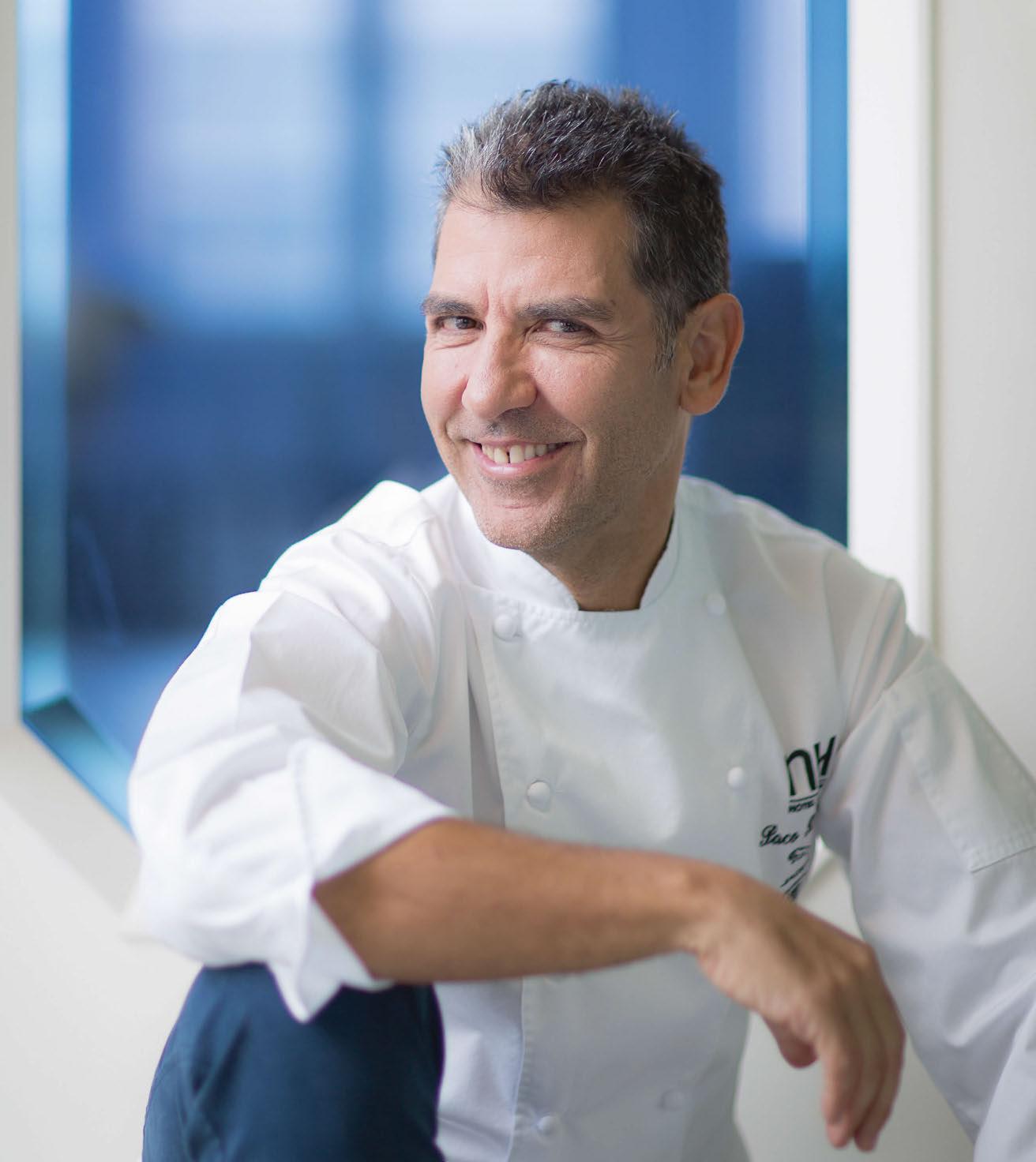
SERVICE
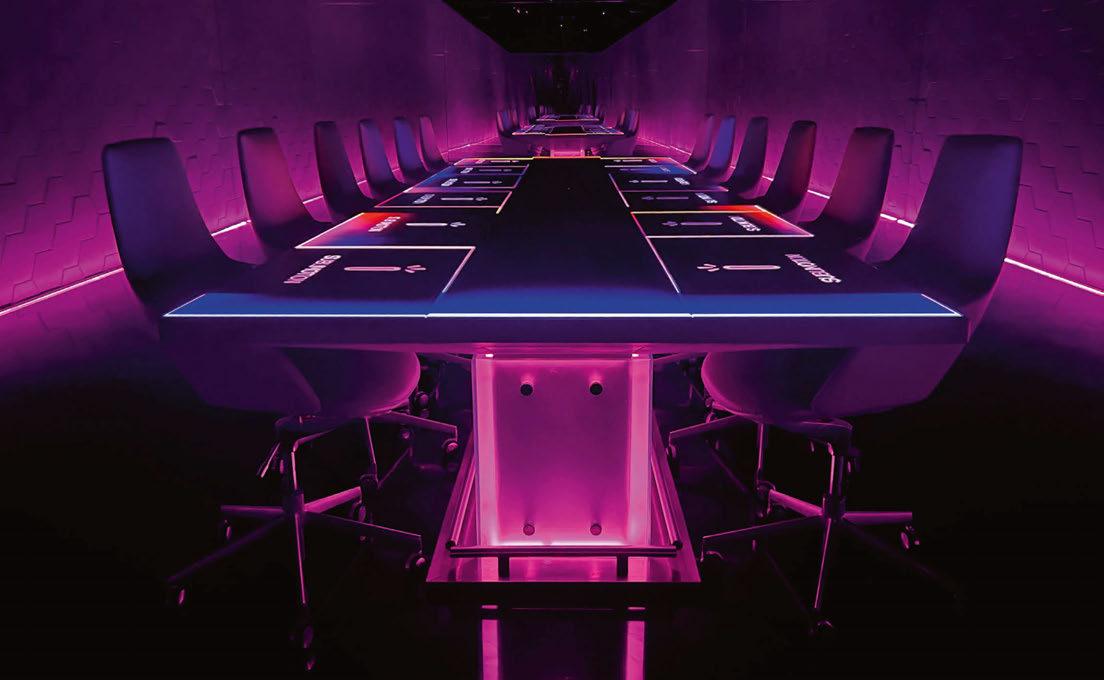


030
© Mario Pinta
Sublimotion comprises a two-hour extravaganza, with more than 20 courses served alongside an innovative entertainment programme
– gather each day before service to make sure every aspect of the experience is executed with as meticulous attention to detail as the evening before. When diners arrive at Sublimotion Dubai, it is to a relatively understated scene: an all-white roofless box bearing each guest’s name projected onto the table. But from that point on, anything goes. Dishes descend from the ceiling on motorised wires, Japanese kaiseki counters materialise seemingly from thin air, Sakura blossom moves across the walls and ingredients pulse on them in sync with the movements of the chefs assembling the food on the plates.
At one point, the room appears to descend through the earth’s crust to a virtual hell’s kitchen, where the Sublimotion devil dances around the guests and flames lick the walls. Later in the two-hour extravaganza, the space is transformed into an aeroplane cabin to the soundtrack of Britney Spears’ ‘Toxic’, at which point the lobster and caviar course is served on economy class-style trays. A giant Jaws-like prosthetic shark head has been known to open up to reveal a tuna galette, and Rubik’s Cube beakers of cocktails that seem to be mixing themselves on the table have also made an appearance, as well as self-spinning turntables displaying the petits fours.
“Think of the craziest thing you can imagine, and we can do it here,” Roncero grins. “Sublimotion is a theatre – it’s a mix of technology, experience, magic and food. We start with a blank canvas and construct on top of that. In the end we just have one goal: for our guests to leave happy.”
Sublimotion – each of which he aims to visits at least three or four times per season – is just one aspect of Roncero’s diverse professional portfolio. Aside from his other restaurants, speaking engagements,
MasterChef appearances and writing – he has published several acclaimed cookbooks – he makes time to travel frequently to collaborate with his colleagues and contemporaries.
For example, we are speaking in the lobby of the luxurious Tivoli Palace Hotel Setais in Sintra, Portugal, where Roncero has travelled to join forces with the hotel’s recently appointed Executive Chef, the Michelin-starred Joachim Koerper, on creating a one-off tasting menu to round off a special day at Sintra’s Classical Music Festival. The main event was a mesmerising ballet performance by some of the world’s most accomplished ballerinas. Roncero’s contributions to the menu included razor clam in a garlic tartlet, marinated pumpkin flower and mushroom broth and a melt-almostinstantaneously-in-the-mouth black butter bass, all expertly paired with wines from Malhadinha Nova, a winery in Portugal’s Alentejo region. Koerper’s ‘gold bar’ of foie gras and wagyu with watermelon and two dessert courses by the hotel’s pastry chef completed the offering.
“I came not only because of the opportunity to cook with Joachim and to combine two different culturesSpain and Portugal,” says Roncero. “I also think it’s very important to bring my team with me around the world so they can know other chefs, other kitchens, other ways of working and broaden their knowledge.”
He is one of many veteran chefs to have taken up the mantle of imbuing the younger generation with enthusiasm for careers in the culinary arts. “They don’t want to work hard; it’s very difficult to find staff,” he laments. Last year, he was involved in the creation of a culinary school, the MOM Culinary Institute, which provides vocational training and specialised courses
031 SERVICE
“Sublimotion is a theatre – it’s a mix of technology, experience, magic and food.”
Sublimotion is where Roncero gets to let loose, playing with multifaceted culinary and theatrical concepts

about the science and culture of gastronomy in the 21st century – though a mismatch between his objectives and those of his partners resulted in him walking away from the project. But he won’t give up easily: “Many students write to me every day asking for advice,” he says. “We plan to build a new cooking school, we have lots of ideas and a huge desire to train the professionals of the future. I don’t want my knowledge to be lost – I want to pass it down to the younger generation.”
As 2022 draws to a close, Roncero’s energy levels are even higher than usual. This is a man who regularly completes Ironman challenges and never misses a New York marathon. He took a long holiday earlier in 2022 and is newly refreshed for the second season of Sublimotion Dubai, but also ready to expand his empire significantly further. New outposts of Sublimotion are planned for South Korea, Saudi Arabia and Brazil, for starters – and though timeframes are still to be confirmed, what is certain is that the prep work will involve a
careful study of the cities and potential hotel partners. The main criteria, he says, are that they share the same objectives and are equally committed to the pursuit of excellence. Dubai and the Mandarin Oriental was an easy decision. “Dubai is an international city open to the world and Mandarin Oriental are the best partners we could have,” he says.
It’s the diversity of his existence that Roncero most relishes. “I love my life,” he twinkles, “I love all the parts of my job: the planning, the careful management control, developing new concepts, creating new dishes together with the team and testing them, customer service and attending gastronomic congresses around the world.”
Though a current knee injury may be temporarily slowing him down on the running front, his excitement is palpable when asked what other projects are in the pipeline. “New amazing things will come that I hope to be able to talk about very soon!” he says. In the meantime, there is plenty to keep him busy.
032 SERVICE
“Think of the craziest thing you can imagine, and we can do it here.”
© Mario Pinta


Terra

No Limits
As one of Italy’s most successful chefs, Enrico Bartolini is famed for a creative cuisine that honours tradition, seasonality and ritual.
Sunlight floods through large windows offering views over Tortona, Milan’s design district, where Enrico Bartolini sits on a sofa in pristine chef whites. A neon sign above him reads ‘One day, I’m gonna make the onions cry’, but the Italian culinary star’s smile is warm.
We’re sipping espressos before service in the discreet dining room at Mudec, Bartolini’s three-Michelin-starred destination restaurant of only eight tables, located on the third floor of Milan’s Museo delle Culture, his flagship venue housed in an ultramodern building designed by the British architect David Chipperfield. There’s a bustling bistro three floors below, but up here the space is tranquil – much like the man himself.
“A restaurant is like a family involving many layers of creativity and talent,” says Bartolini who, in his forties, holds more Michelin stars for his restaurants in Italy than any other chef. In 2016 he became the first chef in the history of the Michelin Guide to be awarded four stars simultaneously, including two for Mudec. His repertoire now encompasses nine stars, including the cosy one-star Ristorante Casual in Bergamo’s old town, the two-starred Glam, a seductive dining salon at Palazzo Venart in Venice, and the two-starred Locanda Sant’Uffizio at Relais Monferrato, a converted 16thcentury convent owned by LDC Hotels & Resorts in Piedmont. There’s also ll Fuoco Sacro at Petra Segreta in Sardinia and Il Poggio Rosso Restaurant at Relais & Chateaux Borgo San Felice in Chiant (both starred), not to mention his Tuscan
idyll, the one-star L’Andana. His international outposts include the Ristorante Spiga and Fiamma – both launched in collaboration with Dining Concepts and located in Hong Kong – as well as Ristorante Roberto’s venues in Dubai and in Abu Dhabi, in partnership with Skelmore Hospitality.
Contemporary but classic, Bartolini’s recipes feature simple ingredients fine-tuned to perfection. “I like working with everyday ingredients, but also cooking using special herbs,” he says. “A big part of creativity is about the growing process – how to use the seed, the flower and leaf – always using the whole of the plant as often the part people throw away is the best. I love bitter flavours too. For years, chefs added sweetness and even sugar to dishes or sauces as sweet was fashionable, but I find if you cook bitter things slowly, they garner natural sweetness in an elegant way yet retain bitter notes, like artichokes.”
He strives to offer a different dining experience at each of his restaurants. “Before opening a new restaurant, I look for what’s unique about a place, then match it with local talent,” he explains. “Each requires a creative chef, a captain who’s always in situ, working with local ingredients and specific techniques. I brainstorm with resident chefs, but their message must be strong and not completely led by me, as that’s not good for the guests.”
Bartolini’s reputation is built on dishes that are both at the cutting edge and rich in culinary heritage. He often looks to old recipe books for inspiration. “Cooking hasn’t changed a lot,” he reflects. “Of course, there’s less fat and sugar
SERVICE 035
Words: Renate Ruge • Portrait Photography: © Paolo Chiodini

 © Paolo Chiodini
© Paolo Chiodini
– but how do we apply today’s techniques without losing something special from the past? I like classic cooking with a touch of luxury. I don’t need ‘new’ as I’m boring… But I love discovering new things as I love to be alive.”
At L’Andana, his approach (which is far from boring) translates to a focus on smoked dishes that use zeromiles produce and local seafood. Dinner at his Tuscan trattoria begins with the onsite baker Lisa briefing diners on her fresh-from-the-oven specialities, with bread sliced at the table in a gesture intended to evoke a familiar feeling of home. The ritual seems doubly appropriate, given that the restaurant itself is housed in what was once an ancient granary of the Medici villa. Wooden beams and exposed brickwork lend an intimacy to the space, which is peppered with terracotta bowls and clay plates. The wine cellar displays more than 600 labels, including drops produced by the estate’s owners, the Moretti family.
At the heart of the restaurant lies an old stove, often helmed by Executive Chef Bruni Cossio. “I’d never seen a wood oven in a gourmet restaurant before,” says Bartolini. “Looking outside we realised we could cut and season local wood, using natural charcoal as the hero of our menu.”
This delicious smokiness permeates L’Andana’s menu, even making it into the next-level risotto with turnips and home-grown roasted beetroot. The eggplant on top is cooked over charcoal and spiced, in an evolution of one of his signature dishes at Mudec. The smoked eel and roasted pigeon with fermented grape sauce from nearby vines are among other star plates, while a grilled onion dish punches above its weight. “I think chefs show you the best of their technique with vegetables,” says Bartolini, citing Cossio’s steak tartare, which replaces the meat with chargrilled sweet potato, as another example.
French culinary behemoth Alain Ducasse helmed this restaurant for eight years before Bartolini took the
reins in 2016. He admits: “I was shy at the beginning. When Vittorio and Carmen Moretti first asked me to take over the restaurant, I thought ‘it’s too beautiful and too far away’ [from Milan]. I was 36, and it would be my third restaurant opening in as many months, which seemed like too much.” However, he rose to the challenge with the support of the Morettis, whose Italian family values he admires strongly and whose generous entrepreneurial spirit he attributes in no small part the overall success of the restaurant. “We took over L’Andana and were awarded a Michelin star in the first year,” he reflects. “Receiving a star is beautiful, showing what a restaurant can do – how it compares to others.”
He continues: “I’ve learned a lot working at L’Andana, finding a new team to maintain the right atmosphere for a leading hotel of the world. It’s important to say ‘hello’ to guests but remembering a person’s name means so much more. As a destination, it has it all; a countryside setting, close to the sea, beautiful inside and out.”
Bartolini himself comes from Tuscany, and grew up experimenting in the kitchen from the age of three. He graduated from the F. Martini Professional Hotel Institute in Montecatini Terme before moving overseas to make his mark as a young chef in the kitchens of Paolo Petrini in Paris and Mark Page in London. Back home, under the guidance of Massimiliano Alajmo at Le Robinie restaurant in Oltrepò Pavese, he secured his first Michelin star at the age of just 29, and a second at the age of 33 at Devero Ristorante in Cavenago Brianza.
He is, he says, devoted to Italian produce. “We’re blessed with distinct seasons in Italy,” he says. “You only find asparagus in May and June; white asparagus is only around for 15 days, so forward planning – which I love – is essential. If you wait for it to arrive and your menu isn’t ready, you’re not cooking asparagus. At L’Andana, you have all the traditions of the Tuscan land; cows and wild pigs, on this part of the coast, fish
037 SERVICE
“A big part of creativity is about the growing process – how to use the seed, the flower and leaf – always using the whole of the plant as often the part people throw away is the best.”
Dishes from Bartolini’s restaurants Casual and Glam display his flair for blending modern technique with a traditional approach
like sea bass, and arselle [small, juicy clams]. I’ve never seen them anywhere else.”
It’s a passion that can be a challenge when it comes to his venues in Hong Kong and the Middle East. “In Italy we have beautiful eggplant and tomatoes,” he elaborates. “I once bought some tomatoes at a market in Japan to find they had no flavour and couldn’t use them.”
For his Hong Kong venues he imports certain key ingredients from his homeland, including tipo 00 flour. “I used flown-in produce in Dubai at first, but you get to see what’s good locally,” he elaborates. “I’m not keen on the fish in Hong Kong, but the meat and vegetables are great, so we pick the best of what’s local and cook it with our flair.”
For Bartolini, repeat bookings come down to guest experience. “I want diners to feel comfortable in a beautiful setting, enjoy a wonderful atmosphere and friendly servers,” he explains. “I’m a gentle person. I like to get to know the person serving me when I eat out. All are important elements. It’s not enough just
to have good food. Invest effort and emotion to give guests the best and they’ll spend more than your expectations.”
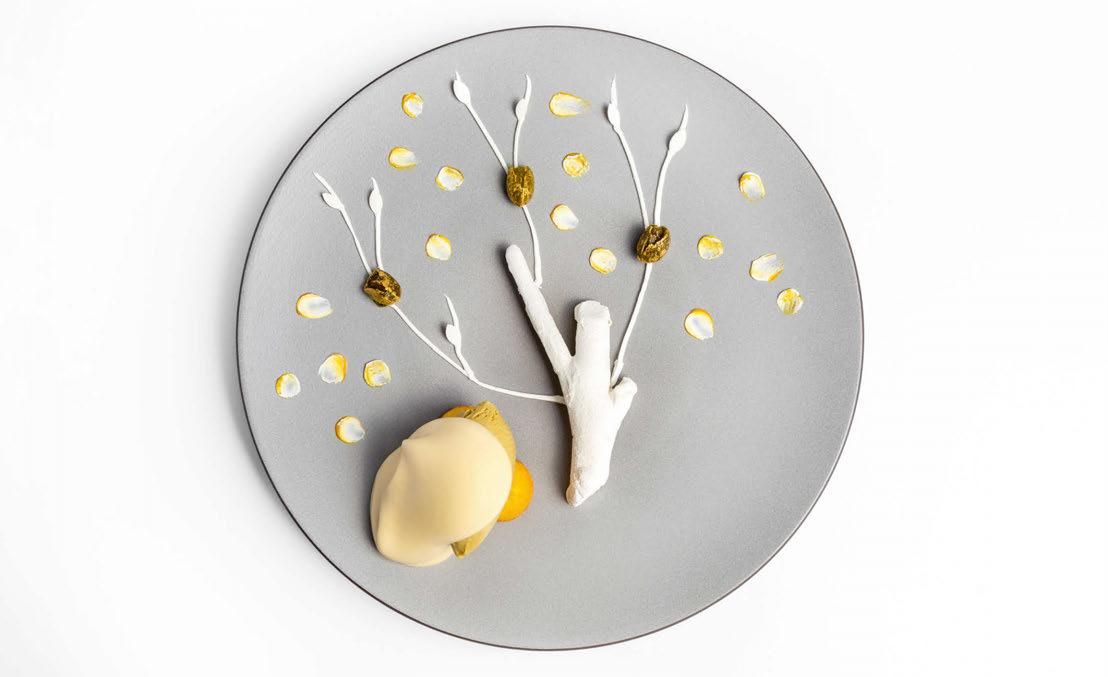
He describes himself as “very detailed, not really like a normal person”, maintaining that while this quality could be seen as a negative, “it’s essential for this style of cooking.” Teamwork is also key. “For our industry, it’s about the ability to be together and share,” he says. “Our world leads us to be extremely individualistic, but a restaurant experience is not a dish; it’s the result of everything.”
And as for what he believes his future holds? “I want to do better,” he asserts. “I don’t have a business partner, so consolidating what I’ve got, with our chefs... We’ll do better together. If a restaurant gets another star the chef is prouder of their place, that can only benefit the guest experience.”
Bartolini’s idea of ‘better’ is probably a bar set so high most wouldn’t contemplate attempting it; but in his view, the sky’s the limit – and his looks set to twinkle with many more stars yet.
038 SERVICE
“It’s not enough just to have good food. Invest effort and emotion to give guests the best and they’ll spend more than your expectations.”

PROFILE
Brooke-Green Head of Food, Mollie’s
As Head of Food at Mollie’s, the fastgrowing concept from Soho House, Kate Brooke-Green has been charged with leading the disruptive brand’s immediate expansion in the UK. Focusing on food strategy, she also heads up people development for an 80-strong foodservice team and will guide the group through the opening of its first city centre concept, set to launch in Manchester in 2023, with onsite F&B outlets including a 164-cover diner, a lounge bar, a shared workspace, private events catering and a grab-and-go offering. Her previous career as a chef and experience as Head of Food Development at The Ivy Collection should stand her in good stead to rise to the challenge.
Upcoming Openings: Manchester, UK (2023)
Striking the Balance
Hip hotel-diner concept Mollie’s has big plans in the UK – and at its helm is Head of Food Kate Brooke-Green, who discusses her winning formula of fostering passion in teams and keeping things simple in the kitchen.
 Words: Shanna McGoldrick
Words: Shanna McGoldrick
Putting a rakish spin on the classic American roadside pitstop has placed Mollie’s well and truly on the map in the UK. The affordable hotel-diner concept has set itself the mission of transforming travel via a distinctive ‘budgetluxe’ offering that leans on nostalgia but applies a contemporary approach to everything from in-room tech to its statement interiors, which are exclusively designed by Soho House. Its allday dining offering is equally as stylish, with a menu running the gamut from build-yourown breakfast waffles and pancakes to classic American grilled cheese sandwiches, ribs doused in BBQ sauce and indulgent bar food such as loaded nachos, hot wings with blue cheese and sweetcorn fritters with spicy mayo. But this is far from a fanciful undertaking: the group has ambitious expansion plans that include opening numerous venues across the UK over the next three to five years, and has already earmarked 10 further locations around the country that will boost its portfolio, which currently comprises outlets in Bristol and Oxfordshire. First up is Manchester, where the new Mollie’s will open its doors in Q2 of 2023 in the city’s seminal former Granada TV Studios location.
MAKING FOOD FUN
With its convivial booth seating and its penchant for comfort food, Mollie’s strives to offer a
crowd-pleasing dining experience that blends a laidback outlook with culinary originality. “It’s a nod to American food, but it’s not strictly that,” embellishes Brooke-Green, explaining that flexibility lies at the heart of the menu. “With the food itself, what we’re trying to do is make it unfussy, but also – and this is a challengeI’m really conscious that I want it to stick within a certain price point. I want it to be accessible to everybody.” On navigating the challenge of striking the right balance between quality and affordability, she says: “We go out of our way to avoid unnecessary frills.”
Brooke-Green is focused on creating a roster of Mollie’s classics, from ice creams to milkshakes, that incorporate innovation but remain accessible for both customers and employees, catering simultaneously to the group’s demographically diverse clientele and a business need to keep things straightforward as possible for the inhouse team. “We’ve got quirky flavours of soft serve coming for the summer and retro desserts like banana split,” she hints, adding that lobster rolls and desserts served tableside are also in the pipeline. “Manchester is going to have a different menu and it’s going to have all those snippets of things,” she reveals.
Naturally, sustainability is also a key piece of the strategy. “Mollie’s has committed to ensuring all plastic items are made from
040
Kate
recycled, recyclable and compostable materials and has opted for refillable products in its motel bathrooms,” says Brooke-Green. “Sustainable thinking will continue to sit at the heart of its expansion as it implements measures to manage environmental impact and further reduce carbon footprint in the years to come.”
PEOPLE POWER
Brooke-Green initially trained and worked as a chef for the first chapter of her career –a foundation she believes provided her with an invaluable understanding of the highs and lows of working in the hospitality industry. At Mollie’s she is driving a culture of positivity in terms of recruitment and retention, and is keen to motivate and champion younger generations who are learning the ropes. “What we’re trying to do is inspire people to fall in love with hospitality again and give them the grassroots training that will allow them to succeed,” she explains.
Given the group’s appetite for growth, an effective staff retention strategy is crucial – but Brooke-Green believes that openness, transparency and an ability to help employees discover various facets of the hospitality machine can be used to help people find their passion.

“Whenever I talk to young people coming into this industry, I think it’s important to talk about all the different possibilities that are out there,”
she says. “There’s the restaurant and hospitality world, but as an offshoot of that that there’s a bigger piece; I think that’s super exciting. There’s so much that goes into building a brand, a restaurant, a business; you can start to inspire people in that way.” In Bristol, for example, Mollie’s is working with hospitality students at local colleges who are invited to come and work in-house – and though they might want to start out as a chef, there are options for them to move into areas such as events or management, depending on their talents and interests. “We have an amazing talent base within the business, a passionate and inclusive team culture, and I look forward to working collectively to establish inspiring training programmes,” she surmises.
ALL ABOUT BALANCE
Cultivating a sense of workplace wellbeing and ensuring that staff are able to enjoy a reasonable work-life balance is a major factor in achieving these sought-after retention levels. “The world is so fast-changing and I’m glad that the hospitality industry is changing for the better,” says Brooke-Green. “Looking back at my past, I wouldn’t want somebody to work an 80-hour week in a London restaurant and slog really hard and then be asked to do something like mend the tiles at the end of the shift. That’s not particularly inspiring.”
In an effort to foster an inclusive environment, she ensures that all recipes are clearly photographed and easy to follow on iPads, making the process as self-explanatory as possible for kitchen employees, while also creating the time for people to pursue training as necessary.
Adaptability is also front of mind when it comes to her focus on remaining competitive. “Inflation is going up, as is the cost of electricity and energy; even to just open the doors is quite an expensive thing, so we have to get the balance just right,” she explains of the group’s imminent launch in Manchester. In response to the challenging climate, Mollie’s is testing out different workflows and means of harnessing staff resources. “If our diner isn’t busy, or our bar downstairs isn’t busy, we’re talking about how we can create a really positive culture and mentality by looking at cross-training, or perhaps moving somebody away to provide help upstairs in the rooms, because they might be really busy,” she says. “We’re trying to build a more harmonious business that can work a lot more effectively, as opposed to everyone working in silo. It comes with its challenges, but I think giving a really good work-life balance and having a great working atmosphere is so important… If you reward your staff and look after them then effectively, they will reward you and make it a great business.”
041
SERVICE
The Hudson Rooms
Capella
HANOI
Words: Eleanor Howard
Photography: © Studio Periphery
Capella Hanoi is taking an epicurean pilgrimage to New York with The Hudson Rooms, a 120-seat rooftop restaurant and oyster bar inspired by the aesthetics of 1920s New York and the renaissance of travel.

IN A BITE
Owner / Developer: Sun Hospitality Group
Operator: Capella Hotel Group
Interior Design: Brewin Design Office
F&B Manager: William Pravda www.capellahotels.com
Envisioned by Hong Kong and Singaporebased Brewin Design Office, The Hudson Rooms is divided into two areas with the main restaurant characterised by archways, vaulted ceilings and highly-reflective materials. “Our aim was to bring out the golden late afternoon light,” explains Nicole Misir, Director of Brewin Design Office. “Hence we clad the length of the south-facing wall with frosted bronze-tinted mirrors to reflect the sun that pours in through arch-framed windows.” Contrastingly, the members’ lounge uses darker-toned timber, stone and stucco to cultivate a more intimate and cosy atmosphere.
“The building’s architecture was a big influence for the design of The Hudson Rooms,” reveals Misir. “The gracious height of the glass enclosure on the roof and the vertical mullioned
window frames presented an opportunity to fit a complex vaulted ceiling system into the large room. The ceilings are inspired by the Grand Central Oyster Bar, one of New York’s first proper seafood restaurants that opened in the 1920s, and the design naturally flows from this anchor reference. Our scheme is designed to be reminiscent of this era with details such as trims and stepping motifs.”
Reflecting the glamour of the interiors, the F&B offering takes guests on a culinary voyage similar to the one made by explorer Henry Hudson upon his arrival to New York. The elevated seafood menu pays homage to traditional recipes from the golden era of the ‘Big Oyster’, prepared with a contemporary twist. The beverage programme, curated by William Pravda, follows the same approach and includes a vibrant cocktail menu that follows the routes of the legendary trains that departed from Grand Central’s platforms to weave their way across North America throughout the 1920s and 1930s, from Chicago and Miami to Canada.
STARTER 042
REVEAL’UP
An elegant, technical and versatile crystal glass stemglass
A chimney in the upper part of the bowl for a unique design, a high level of comfort in tasting, but also to attenuate the perception of alcohol in young wines

Velvet Corinthia
LONDON
Words: Catherine Martin
Photography: © Alex Upton
Apalette rich in colour, material and texture has come to define the David Collins Studio aesthetic in recent years, with the London-based firm responsible for the interiors of some of the world’s best bars. Having designed The Connaught Bar, Artesian at The Langham and the original Blue Bar at The Berkeley, the team have worked their magic at another of London’s luxury hotels.
secluded indulgence,” explains Simon Rawlings, Creative Director at David Collins Studio. “It’s about a feeling, the discreet excitement through the pleasure of music and cocktails.”
IN A BITE
Owner: Corinthia Group
Operator: Corinthia Hotels
Interior Design: David Collins Studio
Head Bartender: Salvatore Calabrese
Bar Manager: Christian Maspes www.corinthia.com
Tasked with transforming the former Bassoon bar at Corinthia, David Collins Studio has injected a healthy dose of glamour, courtesy of sumptuous interiors that speak of a bygone era. Entered through heavy drapes, the venue – aptly named Velvet – is cloaked in lashings of red velvet, with the sumptuous upholstery covering armchairs and banquettes, and hanging as theatre-style curtains that frame the bar to dramatic effect. Seductive lighting, an elegant marble fireplace and newly commissioned artwork by Robson Stannard complete the look. “For me, Velvet captures the essence of a mood – the spirit of intimacy, extravagance and

Indeed, the live music and cocktails are central to the experience, and at the helm is acclaimed bartender Salvatore Calabrese, aka The Maestro. His menu features 1920s classics such as Champagne Charlie and the prohibition-era Bee’s Knees, as well as 2020s creations including Velvet Smash, a vibrant mix of Tanqueray No. 10, basil and lemon juice. And naturally, Calabrese’s much-loved martinis make the list, prepared in his signature style of bringing theatre to cocktail-making.
“We want to celebrate the magic and theatre of hospitality, with a cocktail list of sophisticated classics, that have stood the test of time, alongside modern drinks which are now well-established in the 2020s,” enthuses Calabrese. “Velvet is a seductive, intimate bar that we know will become one of the most desirable destinations in London.”
STARTER 044

2023 WWW.ZIEHER.COM
STOMP! - exclusive novelty
Visit us: Ambiente, Frankfurt a.M. 03.02.2023 - 07.02.2023 Horeca: hall 11.0 booth C30 | Retail: hall 12.1 booth C43
The Vasper Mondrian
NEW YORK
Park Avenue
Words: Shanna McGoldrick
Photography: © Paolo Verzani
Mid-Century, big city dining has returned to downtown New York with the launch of The Vasper, the new culinary offering from Mondrian Park Avenue. Inspired by the seminal design movement, this 120-cover American bistro doffs its cap to the 1950s and 60s with a lively bar, softly-lit dining rooms and tasting counter that DMDesign and Mckay Architecture have rendered both minimalist and sophisticated, through the inclusion of details such as lush greenery, cosy booths and a showstopping chandelier.
equally polished: in addition to Hawkins’ take on the classic gin martini – which features Txakolina vermouth, house giardiniera and spiced olive brine for an extra kick – the venue’s cocktail menu standouts include a Bitter Rum Mojito made with mint bitter caramel, and a Mezcal Paloma Whip that incorporates dry grapefruit soda and chilli salt.
IN A BITE
Operator: Ennismore
F&B Partner: Helios Hospitality
Interior Design: DMDesign, Mckay Architecture
Executive Chef: Nick Koustefanou
Beverage Director: Evan Hawkins www.sbe.com
But the decor isn’t alone in harking back to a more glamorous age. Led by chef Nick Koustefanou and mixologist Evan Hawkins, The Vasper honours an era of opulent dining and deals made over midday cocktails, offering a prix-fixe martini lunch that is sure to evoke tingly warm feelings of nostalgia in diners. Menu highlights include decadent bistro classics such as beef tartare with devilled egg mousse and toasted sourdough, and an indulgent lobster thermidor for two. The drinks programme is
“Though classically American, the modernisation of the notably Mid-Century dishes is executed in a more eclectic interpretation,” says Koustefanou. “Our tasting counter affords us the opportunity to create unique menus for private clients and events.”
Paul Seres, Founder and COO of the venue’s partner, Helios Hospitality, adds: “The Vasper is a reflection of both New York’s culinary heyday and the continued innovation we see in modern restaurants. With the return of office culture, happy hours and business dinners, The Mondrian struck us as the ideal location for honouring the culinary and cocktail culture made famous in postwar America.”

STARTER 046



Legacy
The Grand
YORK
Sustainable British dining is given a creative twist at York’s new fine-dining venue.

From the Romans to the Vikings, various remarkable civilisations have forged, chiselled and knocked York into the multifarious historical city it is today. Though famous for its mediaeval walls, the city’s diverse infrastructure includes Georgian townhouses, a Victorian railway station and centuries-old cobbled streets, with the stitched-together architecture bearing the smudgy, stone-worn handprints of time on practically every surface.
Legacy, then, is a fitting moniker for York’s latest innovation: a fine-dining restaurant at one of the most eminent hotels in what is, these days, firmly a foodie destination. Luxurious independent hotel The Grand, which sits tucked just inside the city walls in easy view of the River Ouse, is making a statement with the latest addition to its culinary offering, which opened its doors last August.
The 26-cover restaurant is housed in a striking circular room (formerly a private dining room), refashioned by the interiors studio Faber Design into an intimate yet elegant space.
The revamp showcases the stately original oak panelling and Edwardian architectural features of the building, which was constructed in 1906 as the headquarters of the North Eastern Railway company, with contemporary decorative techniques woven throughout. Blueprint murals, sculptural lighting and industrial ironwork pay tribute to the engineers and architects of the city’s industrial heritage, while also maintaining a cosseting and relaxing ambience for its diners.
Legacy’s culinary experience actually begins in the adjacent White Rose Lounge, where the team serves arrival cocktails and canapés before inviting guests into the restaurant for an overview of the culinary concept. On the menu: a varied and balanced eight-course tasting menu that delivers locally sourced and sustainably crafted dishes that spotlight seasonal vegetables, regional produce and Head Chef Ahmed Abdalla’s imaginative approach to contemporary British cuisine. Each dish, presented on Goodfellows dinnerware, is
049
MAIN COURSE
Words: Shanna McGoldrick Photography: © Courtesy of The Grand, York
Legacy’s varied and balanced tasting menu delivers sustainably crafted tasting courses that spotlight British produce
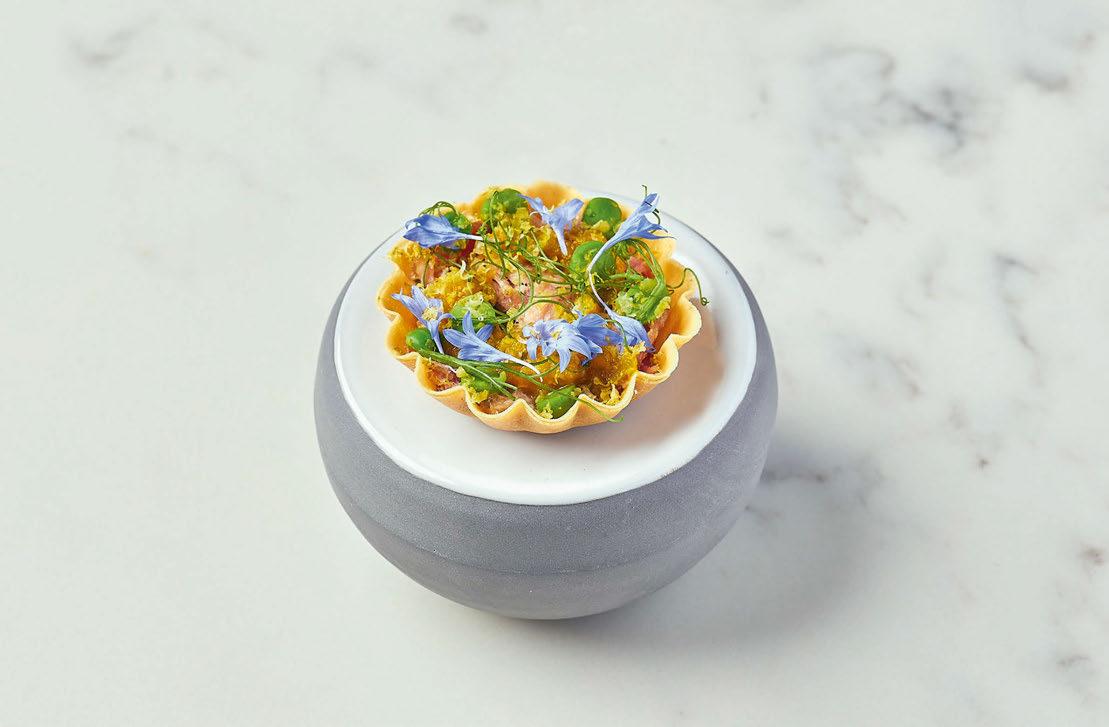
accompanied by a wine pairing hand selected by Derek Scaife, the in-house sommelier.
“This must be a destination offering more than just great food – of course this will be paramount, but I want to really elevate the guest experience from start to finish,” confirms Abdalla. Sustainable sourcing is also an imperative aspect of the process, and most of the produce that makes it onto the plate comes from within a 50-mile radius of York. “It’s vitally important to ensure we know where our produce is from and develop local relationships with our suppliers,” stresses the chef.
The wider hotel’s easy, established charm can be felt in the rhythm and pacing of the courses at Legacy, with each accompanied by a brief explanation of its ingredients and the drink it has been paired with; an interaction that invites diners to press for further information, or tuck straight in as preferred. Comfort is critical here, from the warming candlelight and soft acoustics to the plates themselves. The culinary experience begins with a fresh-from-the-oven
Parker house roll whose warm, pillowy dough is best smothered in a generous slather of the goat’s herb butter sourced from a supplier in neighbouring Lancashire. An autumnal menu then turns to a Jersey Royal velouté made from oak-smoked cheddar and juicy chicken skin that is both hearty and restorative, rounded out by an oaky 2018 Domaine de Montmain, Grand Reserve chardonnay. Then comes salt-baked celeriac served with black garlic and truffle –a favourite of Abdalla’s – and halibut sourced from the local fishmonger Fowlers, presented with cauliflower and mousseline sauce. A trio of Yorkshire lamb dished up with seasonal turnip and courgette digs into the agricultural roots of the region, while the restaurant’s signature grand honey dessert, made with yuzu and elderflower, comes courtesy of the bees kept in hives on the hotel’s roof. “I usually go out to the table at the end of the meal with it to allow the guests to cut a cube of honey straight from the honeycomb - I think that is as local as it can get!” says Abdalla.
050

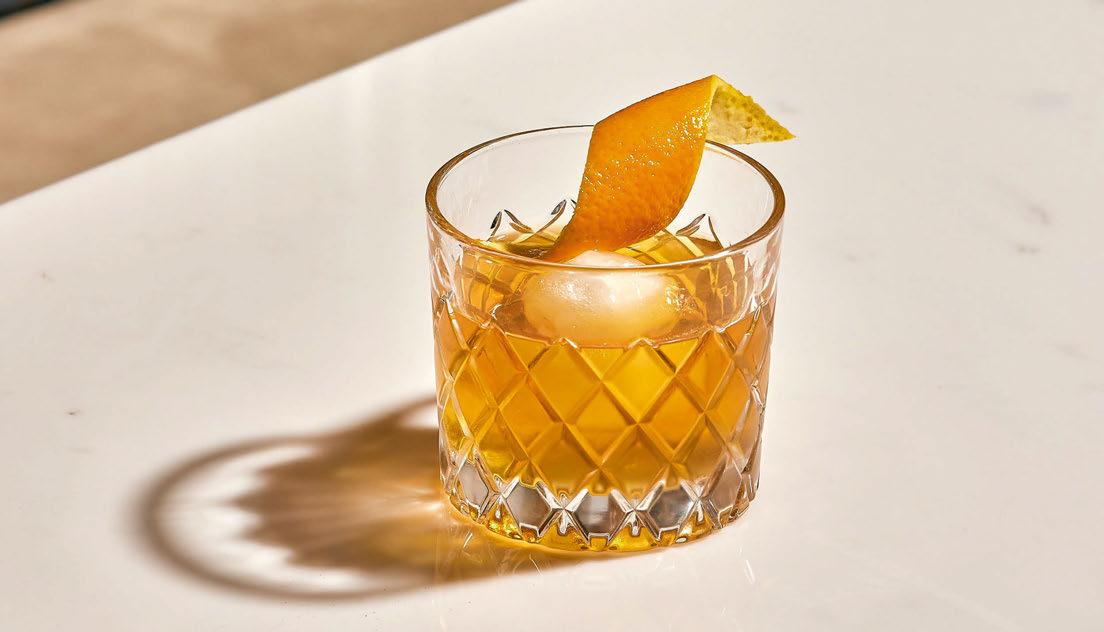

051 MAIN COURSE
Gastronomically speaking, Legacy strives to be as local as possible – but when it comes to the wines, adventure is the name of the game. The tasting menu offers diners either a classic or a premium pairing experience – each curated by Scaife, who painstakingly matches the flavours and textures of each course to a finely-balanced grape-based counterpart. “I aim to take the guest on a journey around the world, and one of the challenges in creating wine flights is using only one country once,” the sommelier explains. “The main aim, where possible, is to use grapes that guests may not know of: for example, Austria offers some great gastronomic whites and red wine that most may not have experienced.” And lesser-known grapes might not be the only discovery in store for diners: “Vegan wines are important and highlighted on my list, but also organic and biodynamic ones, and the approach to winemaking that these demand,” explains Scaife.
When it comes to non-alcoholic alternatives, Scaife and his team prefer to pair mocktails
rather than non-alcoholic wines to tease out the flavours of each dish. “It helps me to use fresh produce, and using the same process with wines to pair the cocktails, such as acidity, mouth feel and depth of flavour,” he divulges.

A constantly-evolving seasonal menu demands that Scaife and Abdalla work closely together on eliciting optimum pairings and a flawless tasting experience for guests – “the man is a walking encyclopaedia,” says Abdalla of his colleague. As the venue’s scope grows and the culinary team looks to nurture close relationships with more local suppliers, this collaborative dynamic will remain the essence of Legacy’s concept, with great importance placed on offering diners a personal touch. “The experience we provide is very intimate, which you won’t find elsewhere,” concludes Abdalla. Like the relentless innovations and transformations that have shaped its history and landscape, York’s newest gastronomic hotspot will be hoping to leave its own indelible mark on the fabric of the city.
IN A BITE
Owner: Splendid Hospitality Group
Interior Design: Faber Design
Head Chef: Ahmed Abdalla
F&B Manager: Seif Djouani
Head Sommelier: Derek Scaife
Dinnerware and Serveware: Goodfellows www.thegrandyork.co.uk
052
MAIN COURSE
THE ART OF SERVICE

CROSS FINISHINGS
HEPP finishings add that special something for a magical table ambiance, e.g. stonewashed, glass bead blasted or brushed combined with the stylish PVD variants gold, pale gold, copper, gun metal or black.
AVES – Dynamic lines





The design of HEPP’s cutlery collection AVES is based on the contours of a bird’s wing. The streamlined appearance has many stylish details that leave a lasting impression and the interplay of strong and slender sensations lends particular elegance. AVES looks graceful and yet impressively adds the finishing touches to a luxuriously set table.


www.hepp.de

054
Da Vittorio The Reverie Saigon
HO CHI MINH CITY
The Reverie Saigon ups the fine-dining ante by opening the first Vietnamese outpost of a family-run, triple-Michelin-starred brand known for its unmistakable style of Italian gastronomy.
When The Reverie Saigon debuted in Ho Chi Minh City in 2015, it introduced a plethora of new eateries to the scene, including an Italian venue. Fast forward seven years and the Vietnamese appetite for Italian dining experiences shows no signs of abating. As a result, the hotel’s culinary offering is moving up a gear with the opening of Ho Chi Minh’s first fine-dining Italian restaurant that brings a three-Michelin-starred brand direct from the Bergamasco foothills to the busiest boulevard in Vietnam’s biggest city.
Both Pope Francis and former US president Barack Obama have eaten Da Vittorio’s signature paccheri pasta, the large tube-like morsels the perfect vehicle for a rich tomato sauce that is finished tableside for a touch of theatre. At the new Vietnamese outpost, this tradition is replicated to perfection by Chef Matteo Fontana, who tosses the vibrant orange-red sauce at speed to keep the air within before plating up for diners, their clothes preserved from splatters by fancy bibs rustled up especially for this course. The lucky head of the table receives the whole pan and is challenged to follow the great Italian tradition of ‘fare la scarpetta’, which means using the homemade bread to soak up the tomato-rich spoils.
To ensure the integrity of this interaction, Fontana spent two years training with the Cerea family in Italy. Brothers Chicco and Bobo are responsible today for this family-run

055
MAIN COURSE
Words: Neena Dhillon • Photography: Courtesy of The Reverie Saigon
In step with the rest of The Reverie Saigon, Da Vittorio features Italian furnishings set amid a backdrop of striated marbles and polished stone
gastronomic brand having inherited the reins of the flagship restaurant from their parents, who originally began serving diners in the Bergamo region in the 1960s. For the 2022 launch of Da Vittorio Saigon, the brothers flew in to give Fontana their seal of approval, and they continue to work closely with him on the menu as well as to ensure the warmth and family atmosphere of the original is reflected in Vietnam. Such is his devotion to the family’s approach that one of the first things Fontana did on arrival in the country was to locate an organic farm in Da Lat that could grow tomatoes for the famous sauce, with seeds provided to the growers direct from Bergamo.
“What’s wonderful about their approach is that there are no airs and graces,” says Fontana. “As a chef, you are invited to become part of the family and learn exactly how they charge traditional recipes with innovation and modern techniques. Chicco is the more serious of the two but has a great sense of humour while Bobo is directly involved in the cooking and always
has time for a joke and smile. They treat people really well. Diners love talking to the family who make everyone feel at home.”
Fontana is no stranger to hotel kitchens: stints at Leela Palaces Hotels & Resorts in India and Le Cirque in Abu Dhabi took his career global following time in Italy working with seasoned Michelin-starred chefs such as Ciccio Sultano. This is his first role in Vietnam as an Executive Chef and he’s excited to be at the helm of the second Da Vittorio restaurant in Asia, with the first already a hit in Shanghai.
To cement the team, F&B Manager Roberto Cini Mencacci brings a track record of running Italian restaurants in Asia while Head Sommelier Ngan Tram is in charge of the 400-label cellar and shares her encyclopaedic knowledge of vintages and signature cocktails.
In step with the rest of The Reverie Saigon, the restaurant is decked out with imported Italian furnishings and handcrafted Italian mosaics set against a backdrop of striated marbles and polished stone. Slate grey dining chairs and

056
MAIN COURSE


www.utopia-tableware.com /utopiatableware @utopiatableware See us at Ambiente Hall 11 Stand D49 Featured Product: CT9551 Murra Ash 10.5” (27cm) Coupe Plate
a la’Egg comprises four different and discernible egg textures in a martini glass topped with caviar
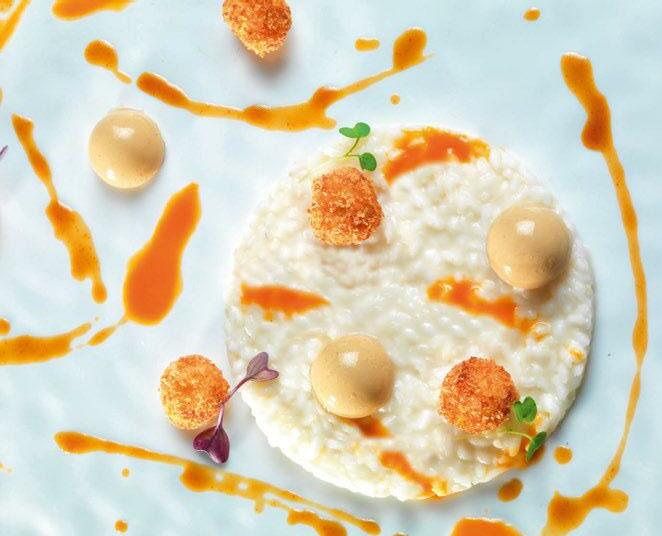

Frette linen tablecloths lend a certain restraint to the décor, which is otherwise unashamedly opulent, rich in dark and sumptuous colours, and wall friezes made from the aforementioned mosaics. European and Asian porcelain brands including Legle, Narumi and Italesse lend gravitas to the dining experience, while Catellani & Smith is responsible for the sophistication of the table adornments. To match the grandeur of the restaurant, service is reassuringly formal yet friendly, with waiters keen to impart information about the gastronomic experience while Fontana pops by at regular intervals to chat about ingredients and techniques.
The eight-course tasting menu ensures that diners in Saigon have an opportunity to sample all the Cerea family’s greatest hits. Of course, there’s the Vittorio-style paccheri pasta paired with a fruity Casanova di Neri Rosso di Montalcino. Before this legendary dish, however, guests are treated to another of the family’s hallmarks, fresh seafood brought to life with expressive notes, mouth-watering accompaniments and subtle twists of flavour.
058
MAIN COURSE
Egg

From gambero rosso delicately fragranced with a gazpacho foam and given a zing with a dash of lemon curd to a clever hot-and-cold raw tuna spaghetti with a bagna cauda sauce and onto a joyous langoustine dish that combines Italian ingredients with Vietnamese flavours, the opening gambit is highly memorable. Wine pairings of a classic Italian Gavi and Sicilian Planeta La Segreta Il Bianco are well considered choices: invigorating, fresh and bright on the palate. The creaminess of a Mediterranean turbot with coconut is followed by the dish that won the family their third star back in 2010. Egg a la’Egg exemplifies Da Vittorio’s philosophy of tradition with innovation, comprising four different and discernible egg textures in a martini glass topped with Amur Prestige caviar. Complemented by a glass of Terlaner cuvee, it is easy to see why the decadent dish shone for its originality and complexity when first sampled by the Michelin inspector over ten years ago. But the tasting menu has yet more to reveal. Pan-seared black cod swims in an impeccable
mushroom broth before the sweet tooth is satiated with a dreamy, deconstructed tiramisu. To close the culinary journey, it’s a return to Bergamo for a typical treat of vanilla creamfuelled cannoncini.
With such a strong presence of the Italian flagship, is there room for Fontana’s own plates?

“Of course, we will retain the signatures from Italy but we also have a few plates specific to Saigon,” he says. “Take our linguine crab, which uses three different types of the crustacean, two of them local, flavoured with mint, candied lemon and a little lemon gel. We’re also keen to showcase seasonal Italian ingredients, with a focus this winter on white truffle, for example.” He concludes by observing that the Vietnamese market is ready for Da Vittorio’s level of assured and elevated fine-dining experience. Underpinned by expert service and unfolding in an ambience that is alluringly Italian, surely it won’t be long before the Saigon outpost wins its own recognition on awards lists and, maybe even, in stars.
IN A BITE
Owner: WMC Group
Operator: Da Vittorio
Executive Chef: Matteo Fontana
F&B Manager: Roberto Cini Mencacci
Head Sommelier: Ngan Tram www.thereveriesaigon.com
060
MAIN COURSE

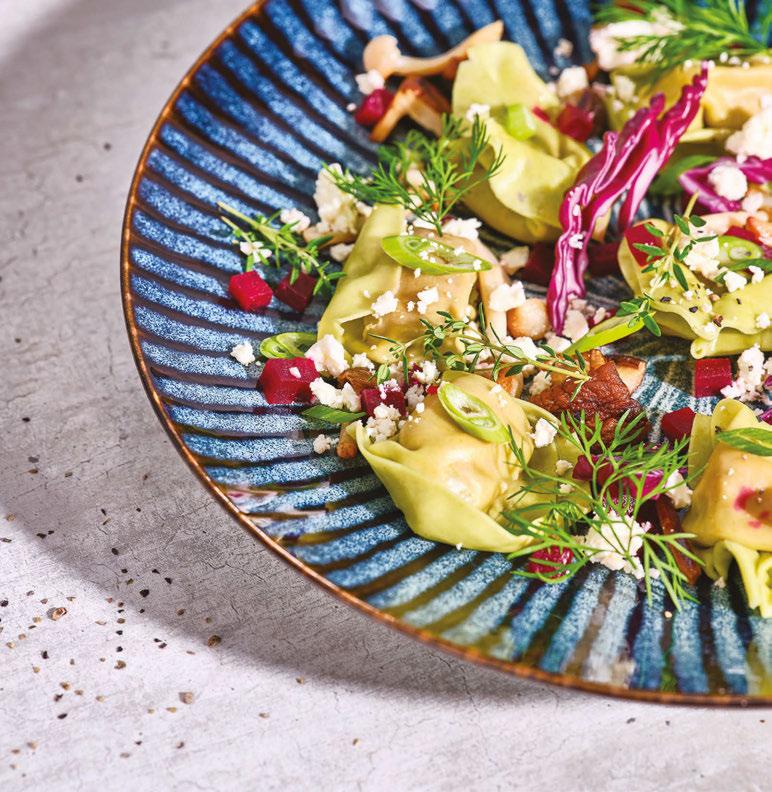



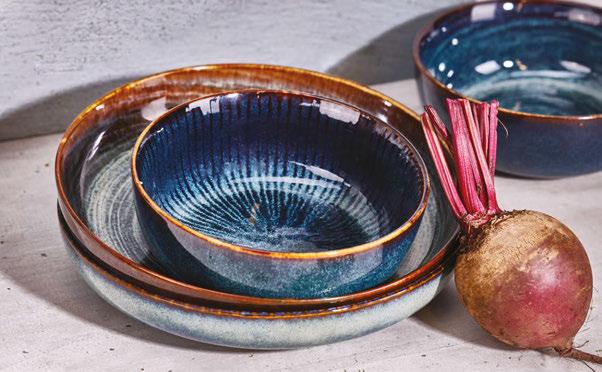
VISIT US AMBIENTE 3 - 7 February 2023 hall 8.0 G50 | hall 12.1 C22 cook dine live
Terre Castlemartyr Resort
CORK

Chef Vincent Crepel adds a dash of theatre to an ambitiously modern fine-dining restaurant on a traditional Irish estate.
Awinter mist rolls through the mossy ruins of an 800-year-old castle built by The Knights Templar, slinks across frostbitten parklands stretching towards a glassy lake and wraps itself around a stately-looking 17th-century manor house. The scene ticks just about every box on the Irish fairytale fantasy checklist – and indeed Castlemartyr Resort, which sits on 220 acres of manicured countryside just outside of Cork, does an excellent line in Celtic charm. But following Singapore-based Stanley Quek and Loh Lik Peng’s purchase of the estate in 2021, the hotel has been quietly undergoing something of a cosmopolitan, contemporary revival.
Chief amongst the updates is the introduction of fine-dining restaurant Terre, which opened its doors in September. The venue is the theoretical and culinary embodiment of French chef Vincent Crepel’s professional journey – which has taken him from the kitchens of Paris to Singapore – and it offers diners a heady gastronomic experience rooted in classical Gallic cooking injected with the zesty flavours of Asia, crafted using produce from Ireland’s verdant terroir. “The philosophy is based on hospitality, ingredients and the journey,” surmises Crepel. “It’s about welcoming people to a place with a lot of heritage that’s doing things in a modern way.”
This journey isn’t merely conceptual: during the course of Terre’s tasting menu, guests move physically between various rooms that differ drastically in terms of ambiance and design. Things kick off in the salon, an historical and lavish space where drinks are served
062
Words: Shanna McGoldrick • Photography: © Barry Murphy

063 MAIN COURSE
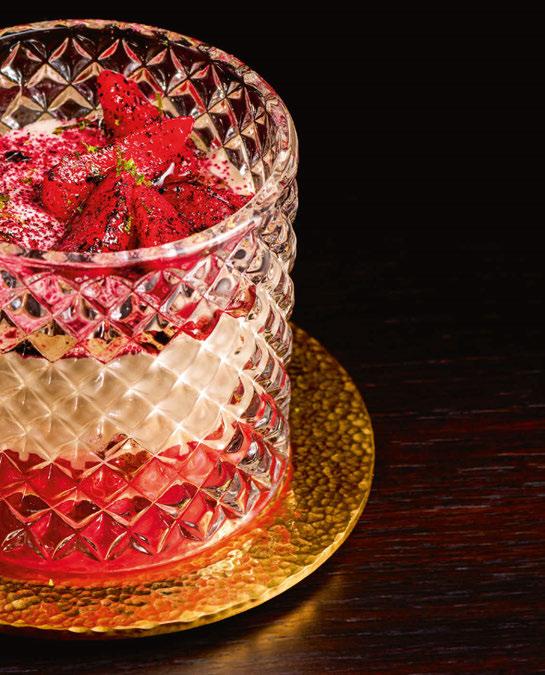


064
by a crackling open fire, before diners are guided into a dramatic black corridor lined, apothecary-style, with all manner of jars containing pickled and brined herbs, fruits and vegetables. This living library of natant produce –dubbed the preservation corridor – showcases goods that have mostly come from Castlemartyr’s onsite garden or the surrounds, presented with a theatrical flair that neatly sums up Crepel’s approach.
Double doors swing open to reveal the kitchen in all its loud, smoky glory, and from behind the pass the chefs look up in unison to greet new arrivals with the rallying cry: “Welcome!” It’s an unexpected touch and one that sets the tone for a heartfelt brand of hospitality that Crepel was keen to convey. There are canapés – artistic single-bite morsels that break into explosions of flavour and texture – more drinks, and an explanation of the ageing fridge where meat and fish from across Ireland and France awaits its fate. Then it’s into the modern, almost austere, dining room for the main courses, followed by digestifs and petit fours in the lounge. The whole experience – in true Irish fashion – proceeds at an unhurried pace, clocking in at more than three hours duration.
“This used to be a boarding school, so there are a lot of different rooms and I felt that we could be very intimate in each room,” explains Crepel of the decision to divide the dinner experience into different factions. “It doesn’t feel like everybody’s in one room, and you can really create a personal connection to each table and to each guest.”
As its name suggests, Terre focuses on the surrounding land and the people that populate it – but it also nods to the worldlier concept of travel and the discovery of far-flung places. Crepel teases out this theme by taking diners on an adventurous global tour, through the creative presentation of rare and exotic ‘star’ produce such as Norwegian hand-dived scallops, the southeast Asian fingered citron Buddha’s Hand, and dried Mauritius pineapple.
How does he strike the balance between producing innovative, internationally inspired dishes and remaining sustainable? “I think sustainability is also about explaining to the guest what this is and where it’s from,” he concludes, adding that the team sources whatever they can from County Cork or from Ireland as a whole, working closely with growers, farmers and fishermen. That said, Terre’s uninhibited international approach is important in differentiating it from other high-end seasonal Irish restaurants. “I’ve travelled a lot; there are a lot of amazing ingredients all over the world and I think people also like to discover things at some point, like Buddha’s Hands from Southeast Asia or the flavour of kaffir lime” he says. “I think people should be aware of them, and I’m happy to share it with them.”
The venue, however, remains firmly rooted in its locale: everything from the tables and chairs to the cutlery is made in Ireland, while steak knives that come from Armagh were adapted from hunting knives and crafted from the bog wood that the Irish have been using to heat their homes for centuries. A few delicate china tableware and serveware pieces from France and Asia accentuate the narrative.
As for the food - bold flavours, unexpected textures and exquisite presentation are par for the course. The opening canapés estsblish the mood, with smoked milk-fed veal served with kalamata olive, anchovies escabeche and white button mushroom, and blue lobster from the neighbouring village of Ballycotton presented in a celeriac casing and accompanied by dill mayo, confit tomato and dried hibiscus. Once in the main room, the offering becomes even more creative; aged Blue Fin Tuna belly is combined with verjus and purple radish and marinated in trout vinegar, served with trout roe from Kilkenny, while the chawanmushi sees steamed dashi, foie gras, eel, wagyu ham and mushroom coulis combined in a powerful, earthy punch. Turbot sitting in a lake of vermouth beurre blanc and served up with jasmine caviar and rose oil is delicately luxurious, and the
065
MAIN COURSE
Terre’s preservation corridor showcases pickled and brined produce harvested from the hotel’s grounds and the local region
main course on Supper’s visit – French quail, aged for seven days and cooked over bincho, served with celeriac extraction, pied de mouton and smoked porcini oil – was at once surprising and immediately comforting. Petit fours see Crepel indulge in a touch of nostalgia, courtesy of robust chestnut honey madeleines and the light-as-air cream and icing-sugar sponge cake confection that is the St Tropez. Wine pairings throughout focus on family-owned producers and highlight biodynamic and organic methods.
Cork has a reputation for being Ireland’s food region, but why did Crepel feel that the Castlemartyr Resort specifically was the right place to launch his first solo venture outside of France? “I felt like the space was great and the area, which is actually quite off-the-map, taught me a lot about being very focused,” he says. “The space is amazing and I think what we have – Terre – I’m privileged to have that.”
Currently the majority of diners are Irish, which Crepel loves, but he hopes to attract a more international audience soon, helping
overseas visitors to discover the hotel. “I would like this place to become a place to travel for,” he says, an ambition that will surely be bolstered by the reputation of Loh Lik Peng’s Unlisted Collection of hotels and restaurants in London, Shanghai, Sydney and Singapore. Crepel also has big plans for a Terre breakfast featuring the jams, honey and charcuterie produced onsite, is currently working on a cookbook and would eventually like to open a boutique within the hotel. The goal is to encourage culinary breaks that capitalise on the property’s remoteness, with the chef joking: “The good thing about this place is the location, and the bad thing is the location.”
The most important thing for Crepel is that guests, regardless of their prior exposure to fine dining, feel welcome. “I want people to feel at ease, I want them to feel relaxed and I want them to be open-minded as much as they can,” he says. “I think the magic happens when they meet the team, and they understand the journey.”
IN A BITE
Owner: Loh Lik Peng, Stanley Quek
Operator: Unlisted Collection
Architecture and Interior Design: John Duffy Design Group
Chef: Vincent Crepel
Head Sommelier: Filip Palfi www.unlistedcollection.com

066
MAIN COURSE

Mural Farmhouse WunderLocke
MUNICH
An ambitious F&B concept at Locke’s new Munich outpost brings an approachability to fine dining and emphasises the importance of eating local.
 Words: Guy Dittrich Photography: © Edmund Dabney (unless otherwise stated)
Words: Guy Dittrich Photography: © Edmund Dabney (unless otherwise stated)
The rooftop of WunderLocke in Munich’s lively Sendling neighbourhood boasts views of the snow-capped peaks of the Bavarian Alps, which, come summertime, will make a theatrical backdrop for enjoying light bites and aperitifs at a pop-up bar. Amongst the dining tables and lounge seating, raised beds are abundant with plant life that serves as the kitchen garden – a telling hint as to the F&B ethos that prevails within.
Flying collectively under the name Mural Farmhouse, WunderLocke’s F&B offering comprises five venues set across seven floors, spanning an all-day à la carte restaurant, a café, bar, rooftop and – in an ambitious move for the hotel – a fine-dining venue with a tasting menu. The philosophy behind the concept is quite literally written on the walls, with bold graffiti-style writing – courtesy of the artist Stohead –revealing the phrase ‘Eat Local. Drink Natural.’
“Our eat local, drink natural ethos underpins everything we do at Mural Farmhouse,” explains WunderLocke’s Head Chef Rico Birndt. “By approaching the project through the lens of sustainability, we challenged ourselves to experiment with new cooking methods that celebrate seasonality in its purest form.”
The circularity of the hotel’s culinary sphere is also seen in other elements of the project; notably the re-purposing of the concrete structure of a former Siemens office building
068

069 MAIN COURSE


070
© Lenka Li Lilling
© Lenka Li Lilling
Mural Farmhouse’s ingredients are all sourced from within the region, with ‘eat local’ an important part of the culinary narrative
and the approach to the interiors taken by Londonbased studio, Holloway Li. “Our design incorporates a series of biophilic inserts,” explains Co-Founder and Creative Director Alex Holloway. “Dense freeflowing planting and natural materials such as timber, terrazzo and raffia provide a natural counterpoint to the omnipresence of concrete.”
In the fine-dining restaurant, where floor-toceiling windows look out to a sunken garden terrace complete with plunge pool, furniture is crafted from large-format terrazzo and timber, while mirrored ceiling panels ripple like the wind on water. Sitting lightly on the existing building, the design allows for flexibility of configuration. The adjacent café-bar doubles as an extensive lounge and co-working space, whilst upstairs is a perfectly-sized, moody cocktail bar with plush velvet and plump leather upholstery. WunderLocke, which opened its doors in the summer of 2022, is the largest of Locke’s 12 hotels to date, and the brand’s second outpost in Munich. The Mural Farmhouse concept follows a successful collaboration with Moritz Meyn and Wolfgang Hingerl – the masterminds behind the city’s hip Michelinstarred restaurant Mural – on the Bambule! bar at sister hotel, Schwan Locke, just a few kilometres away. “After working with Mural to create Bambule! we knew they were the perfect partners to create a distinctive offering at WunderLocke,” says Eric Jafari, Chief Development Officer and Creative Director of WunderLocke’s parent company Edyn.
As the name suggests, Mural Farmhouse’s ingredients are sourced from various farms across the region. Martin and Charlotte at the nearby Hand & Erde supply vegetables. “It is a 30-minute drive each week to collect our vegetables as they are too small to make deliveries,” says Jan Maetzing, F&B Manager of
all the hotel’s venues. That they have been invited to dinner gives a good indication of the level of supplier relationships. Flour and eggs come from Billesberger Hof, an organic farm half an hour away, and the fresh milk and butter from the dairy farm Alztaler Molkerei, near the Austrian border. Organic bakeries Wagner and Julius Brantner, in the nearby neighbourhood of Schwabing, supply pastries and sourdough bread respectively; the fish is from Schliersee, a picturesque lake some 50km south; and meat is sourced from Gutshof Polting, a fifth-generation farming business that supplies the city with the best lamb – though mostly Mural Farmhouse takes meat from wild, freerange animals that Polting hunt themselves.
“We are very strict about the local sourcing,” explains Maetzing, pointing out how useful the rooftop garden has been this first summer. Strawberries, lemon verbena, salads and herbs have all been plentiful – and there are plans to add bees into the mix this spring. Forbidden items include exotic fruits: no mango, berries or even bananas featured in Supper’s early winter breakfast fruit selection, underlining the commitment to seasonal offerings.
A little more freedom has been allowed when it comes to the wine list. “We are international with our wine but all of it is organic and mostly natural,” explains Maetzing. In the fine-dining restaurant, all nine pairings accompanying the 12-course menu come from Europe: earthy wines including a champagne from the eight-hectare Benoit Marguet estate, and some whites with hints of orange.
Alcohol-free pairing alternatives are practically a baseline requirement these days, so the team has developed a range of homemade kefirs and kombuchas for non-drinkers. Unusually, the kefirs are water-based, making their fruity-herby profile
071
MAIN COURSE
both refreshing and longer-lasting than milk alternatives. The tea-based fermentation of the kombuchas provides a tannin-like taste that is more suitable as a replacement for red wines.

The results of these fermentation and pickling techniques are proudly stacked on the top shelf of Mural Farmhouse’s bar, where huge glass jars of beets, cabbage, pears, rhubarb, verbena and asparagus adorn the wall. The approach is a welcome and pragmatic extension of the always-too-short spring asparagus ‘spargel saison’ for which Bavaria is famous.
During Supper’s dinner, seasonal items on the winter fine-dining menu included a fantastic amuse bouche triptych created to look like a posy and good enough to wear on a lapel, featuring five different types of delicate cabbage leaf served with a creamy blue cheese sauce. There was a mouthful of crunchy, charred salsify topped with a smoked cheese, alongside a soup combining the juice of roasted mushrooms and oil of black peppercorns served in a white bowl from the Base series by Piet Boon for Serax.
Supplementing the back-to-basics ideas of preservation are three, glass-fronted dry-ageing fridges, their picture windows full of hanging cuts of meat, carcasses of fish and venison, salamis, root vegetables and, for the winter, a whole dryer full of goose – all of which form part of Birndt’s broader view on sustainability.
He waves to the dryers, explaining: “By ageing the produce under stable conditions, it allows strong flavours to develop.” The fish bones are reduced and then fermented for three months at 60°C to make a fish garum, while the meat stripped from carcasses is for the homemade salami, demonstrating a truly nose-to-tail approach of reduced waste and great flavours.
Vegetables, too, are aged: mushrooms dried for six months taste like chocolate, while certain radishes give the intense flavour of smoked bacon and red beets take on the chewy consistency of ham.
Moving through the fine-dining menu, a dried wild boar fillet is served, its tangy softness contrasting with a crusty sourdough bread and
072
MAIN COURSE
Harvest from the rooftop garden includes strawberries, lemon verbena and herbs, which are used in an array of dishes
© Lenka Li Lilling
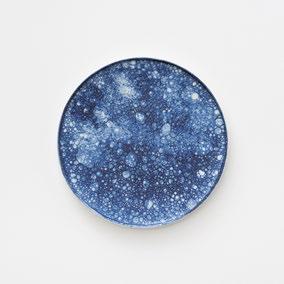















blue cheese and butter mix, itself stored for two months to develop a powerful flavour (a carpaccio of the same boar sees its way on to the à la carte menu in the all-day restaurant).
A light and mineral Riesling Kabinett Röttgen from Mosel Valley counters the richness. A section of crispy-skinned, soft-fleshed pike perch is served with a beurre blanc with fish garum, balanced out by the nutty, yeasty taste of a Claus Preisinger KalkundKiesel pinot blanc from Austria.
In general there is a pureness to the extensive menu, which features small but hearty portions. It’s wholesome – like a “morning muesli” as Maetzing describes the cubed asparagus and liquified blue cheese topped with a roasted potato crunch. “Mix it all up!” he enthuses. Meticulously prepared, the ingredients are beautifully but simply presented; at Mural Farmhouse, it’s all about the tastes, the consistencies and the textural contrasts.
How do Meyn and Hingerl see their concept playing out at WunderLocke? “We have had
the idea for a unique gastronomic concept like Mural Farmhouse for a long time,” says Meyn. “From breakfast through to the relaxed finedining menu, we wanted to provide guests with a unique culinary experience. With partners like Edyn this vision was able to be realised as they were just as enthusiastic about this perfect match between a unique hotel and a top gastronomy offering which is open to all guests and pays equal attention to the visual delight as well as the quality.”
Locke has positioned itself as a lifestyle brand, with its portfolio of aparthotels reflecting its ‘made to be lived in’ slogan, and the ambition to ally the Mural brand to its latest designconscious but nevertheless neighbourhood Munich property says much about a city where fine-dining options can thrive in non A-list locations. The Mural Farmhouse takes its cue from this inclusivity, offering a local connection and a relaxed informality that feels much more down to earth than the haute cuisine often found in the hushed, white-gloved arena.
IN A BITE
Operator: Edyn
F&B Team: Mural

Interior Design: Holloway Li
Head Chef: Rico Birndt
F&B Manager: Jan Maetzing
Head Sommelier: Wolfgang Hingerl, Maxime Joly muralfarmhouse.de
074
MAIN COURSE


Ancestral Fruit
In Portugal’s wild heartlands of Alentejo, a restored 19th century farm and boutique hotel is honouring its heritage by taking olive oil production to new heights.

Alentejo is a wild place. This southern region of Portugal, which stretches from the Atlantic coast to the Spanish border, has an alluring remoteness about it that is enhanced by its hilly, untamed landscapes.
That it feels a world away from Lisbon – and fiercely independent – should come as no surprise: with an agricultural history that dates back to the Neolithic age, this is a place that has held its own against the test of time.
The proof, should you need it, is in the olives. Or rather, the olive trees – which are ubiquitous in these parts; millions of them spread across the region with their delicate silvery leaves and chalk white, twisted trunks marking the entrance to villages, lining roads and decorating the fields with their shady groves. Alentejo, renowned for producing some of the world’s finest olive oil, is home to several trees that are estimated to be 2,000 years old or more.
There are more than 6,600 olive trees at São Lourenço do Barrocal, a 780-hectare estate that has been operating as a working farm since 1820 and additionally, since 2016, a plush 40-key 19th century hotel, winery and spa. The land has been in the same family for eight generations, having been purchased 200 years ago from the royal family and turned into a self-sufficient farming community that in its day was equipped with its own kiln, bakery, schoolroom, flour mill and vineyard. The property has experienced its fair share of instability – Portugal’s political turbulence in the 1970s saw it briefly renationalised by the state – but it has now been back in the hands of the owner, lead developer José António Uva and his family for decades, undergoing,
Words: Shanna McGoldrick • Photography: © Sanda Vuckovic Pagaimo
DINING




© Ash James
in recent years, a lengthy and considered restoration process that not only respects but continues the narrative of its ancient ecological heritage.
“We weren’t interested in doing this project if it was just going to be a hotel,” explains Uva of the renovation works that saw him work with archaeologists, landscapers and architects to subtly transform the low, white buildings of the ‘monte’ farming village into an understated yet luxurious property comprising a winery, a series of expansive guestrooms and residences, a high-ceilinged bar and a pared-back restaurant, not to mention the outdoor pool, sumptuous spa and shop. Instead, the undertaking could more accurately be described as a cultural heritage project; a labour of love that strives to bring the principles of its original purpose into a modern hospitality setting.
Today, Barrocal is almost as self-sufficient as it was in its farming heyday: an extensive vegetable garden means that the estate once again grows much of its own produce, while beehives provide the restaurants with honey and 15 hectares of vineyards produce up to 80,000 litres of organic wine each year.
Alongside the wines – whose local grape varieties include Roupeiro, Arinto, Touriga Nacional and Aragonez – olives have long been another of São Lourenço do Barrocal’s main exports. The hotel usually produces around 160,000 kilos of olives per year, yielding approximately 1,000 bottles of organic extra-virgin olive oil annually – but now, for the first time in decades, the process will take place completely onsite, with Barrocal’s agricultural team harvesting, cold-pressing and bottling within the walls of the estate. The move is thanks to the launch of a brand new olive oil mill that began to produce its first batch of bottles in the Autumn/Winter 2022 season.
Naturally, hotel guests will benefit from the new addition, with plans for a variety of immersive olivethemed experiences in the works. These will range from the chance to join Barrocal’s groundworkers in harvesting the olives from the trees using a traditional, low-intervention method that involves shaking the fruit from the branches with a rod, followed by masterclasses in seasoning that will also expose guests to the property’s homegrown herbs such as oregano, myrtle or orange blossom. Finally there will be trips to the mill to observe the more mechanical stages of the process in which the fruits are crushed, ground to a paste and separated via centrifuge. Al fresco tasting sessions featuring the various oils produced will round out the experience.
Two varieties of olives have traditionally grown on the estate: the plump green Bical, and the smaller, darker Galega. “In Portugal there are maybe 30 varieties of olive; in this region we only use around five, and 80% of what’s used here for the oil is Galega,” explains Luis Lobato de Faria, a historian who conducts guided tours of the Barrocal estate for guests. The hotel uses both in its olive oil production, creating a 100% Bical DOP, a 100% Galega version and a blend of both. The mill uses a low impact coldpressing process that preserves the olives’ specific organoleptic properties and individual flavour profiles, while the absence of filtration methods ensures a strong presence of vitamin E and other natural antioxidants. Anything under 27 degrees falls into the category of cold-pressing, Lobato de Faria explains, while the ‘extra-virgin’ label applies to oils with an acidity level of 0.8% or lower. “Acidity is going to destroy the oil faster and it’s bad for your health,” he says. “The oil produced at São Lourenço do Barrocal usually has an acidity of 0.5% or less.”
LUIS LOBATO DE FARIA
079
DINING
“Olive oil here is very important: it was used for rituals as a sacred oil, and for healing, cosmetics, providing lamplight and also for food – which is the main use today. This is the land of olive oil.”
São Lourenço do Barrocal’s sunkissed ancient olive groves can be explored on foot or by horseback

Lobato de Faria has been taking guests on tours of the estate’s olive groves for some time, teaching them about the centuries-old trees –many of them ancient millenary trees – onsite and weaving tales about Alentejo’s agricultural heritage, ancestral farming traditions and socio-political history generously through the conversation. His olive grove tour begins in São Lourenço do Barrocal’s old mill before moving through the grounds, examining some of its most enduring and beguiling trees and touching upon the various methods that go into protecting, maintaining and harvesting the stock. The experience, which wraps up with a tasting session that features all three of the hotel’s blends, is immensely popular with guests. “People already have an idea of Portuguese wine,” he explains of the growing interest in the topic. “Now they are starting to understand that the olive oil is also very good.”
The tour offers a fascinating insight into the rituals that have shaped Alentejo, taking in several of the imposing ancient rocks known
as ‘barrocais’ – many of them sacred – that lie dotted around the estate, often half-burrowed between a band of olive trees. Thought to date back to the Neolithic era, they have been sites of worship since pre-Pagan times and represent a link to a past that incorporated the Iron and Bronze Age through to Roman and Moorish occupations of Portugal. Lobato de Faria is also a wealth of knowledge when it comes to educating guests about the various species of trees and the history of their importation, pointing out that domestic olive trees that have been grafted onto wild ones, with the newer plant effectively growing inside the ultra-resistant skin of the original and often resulting in a single tree that bears two different types of fruit.
Alentejo, which is home to the largest olive grove in the world, takes its olives very seriously indeed, and the guide spins yarns about the fruit’s ancient uses over the centuries. “Olive oil here is very important; it was used for rituals as a sacred oil, and for healing, cosmetics, providing lamplight and also for food – which
080 DINING
Ash James
©

Create and live a unique experience.
french family-run company since 1768 revol1768.com
Photo: Franck Hamel
Olive oil features heavily in the hotel’s culinary offering, with al fresco tasting sessions a popular guest activity

is the main use today,” he explains. “This is the land of olive oil.”
Naturally, the golden nectar takes a starring role in the hotel’s guest offering, appearing on the spa menu where it is infused with organic herbs for added relaxation, and in the onsite shop, where guests can stock up before the journey home. It also features heavily in the culinary programme. It’s no coincidence that São Lourenço was the patron saint of cooking –the property is passionate about its reputation for gastronomy, and olive oil is used liberally throughout its breakfast, lunch and dinner menus. “Olive oil is the basis of Portuguese food, especially in the Alentejo,” explains Head Chef Nuno Fernandes, who works alongside Executive Chef Celestino Grave on curating the acclaimed seasonal menus. “Every savoury dish here contains our olive oil – and even some of the desserts. It’s part of our heritage; both at the hotel and within the region.”
At the farm-to-table restaurant – a simple, rustic affair that belies the delicacy of its
gastronomic approach – the focus is on authentic local dishes made with the freshest seasonal produce. Highlights on the autumnal menu include Barrocal veal tartare with horseradish mayonnaise, a simple pumpkin soup featuring vegetables from the garden, and duck served with Alentejo pork sausages and creamy barley. But one of the most striking dishes is served before the meal begins, when diners are presented with a helping of artisanal Alentejo bread, a bowl of lightly seasoned, glistening olives, and a saucer of silky, golden-green oil for dipping. Additional highlights include a moist, crumbly olive cake, a Portuguese speciality.
The decision to invest in a functioning olive mill at São Lourenço do Barrocal is proof of the long-term vision at play here – after all, as Uva points out: “You nurture olive groves for your kids.” This sense of continuity, of preserving a sustainable link between the past and the future, runs like a thread through this hotel and its desire to honour its history while sharing the fruits of its heritage with its guests.
082
DINING
© Ash James

NYEWOOD, ROGATE, PETERSFIELD, HAMPSHIRE, GU31 5HZ Tel: 01730 821811 Email: office@johnjenkins.co.uk NEW YORK SHOWROOM, 41 MADISON AVENUE, 9TH FLOOR, NEW YORK NY 10010 Tel: 1-800-818-8484 www.johnjenkins.co.uk A perfect cocktail...the perfect glass Glassware for Professionals
SIGNATURE
In Mexico’s Baja California, the newlyrefurbished hotel Rancho Pescadero is focusing its epicurean efforts on showcasing the local terroir. Culinary Director Chef Sandro Falbo celebrates the region’s cultural traditions using strictly native ingredients.

No dish epitomises his approach more than the Herbed Fruit Salad, composed entirely of produce harvested directly from the property’s traditional ‘huerta’ garden. Tangy strawberries, smooth agave nectar and a punchy Jamaica hibiscus flower combine with the smokiness of herbs such as tarragon, basil, dill and mint, with fresh, crispy and juicy results. “I consider strawberries and cherry heirloom tomatoes as having the same role in this salad,” says Falbo.
The dish is relatively simple to make: once the ingredients have been picked from the garden, they are mixed together and drizzled with a dressing made from boiled hibiscus flowers whisked in agave honey and seasoned with salt and pepper. “The trick is to have all the ingredients fresh from the garden, picked just at the right time – and to avoid using the fridge,” the chef explains.
As Baja California cycles through the seasons, Falbo plans to add pepita pumpkin seeds or amaranth to the salad, and perhaps a sprinkling of local goat cheese. But it will always be a favourite on warmer days. “It’s the perfect, uncomplicated fresh dish for our summer here,” he concludes.
Herbed Fruit Salad Rancho Pescadero
BAJA CALIFORNIA
© Alfredo Gómez, Argo Studio

Red Veg Carpaccio
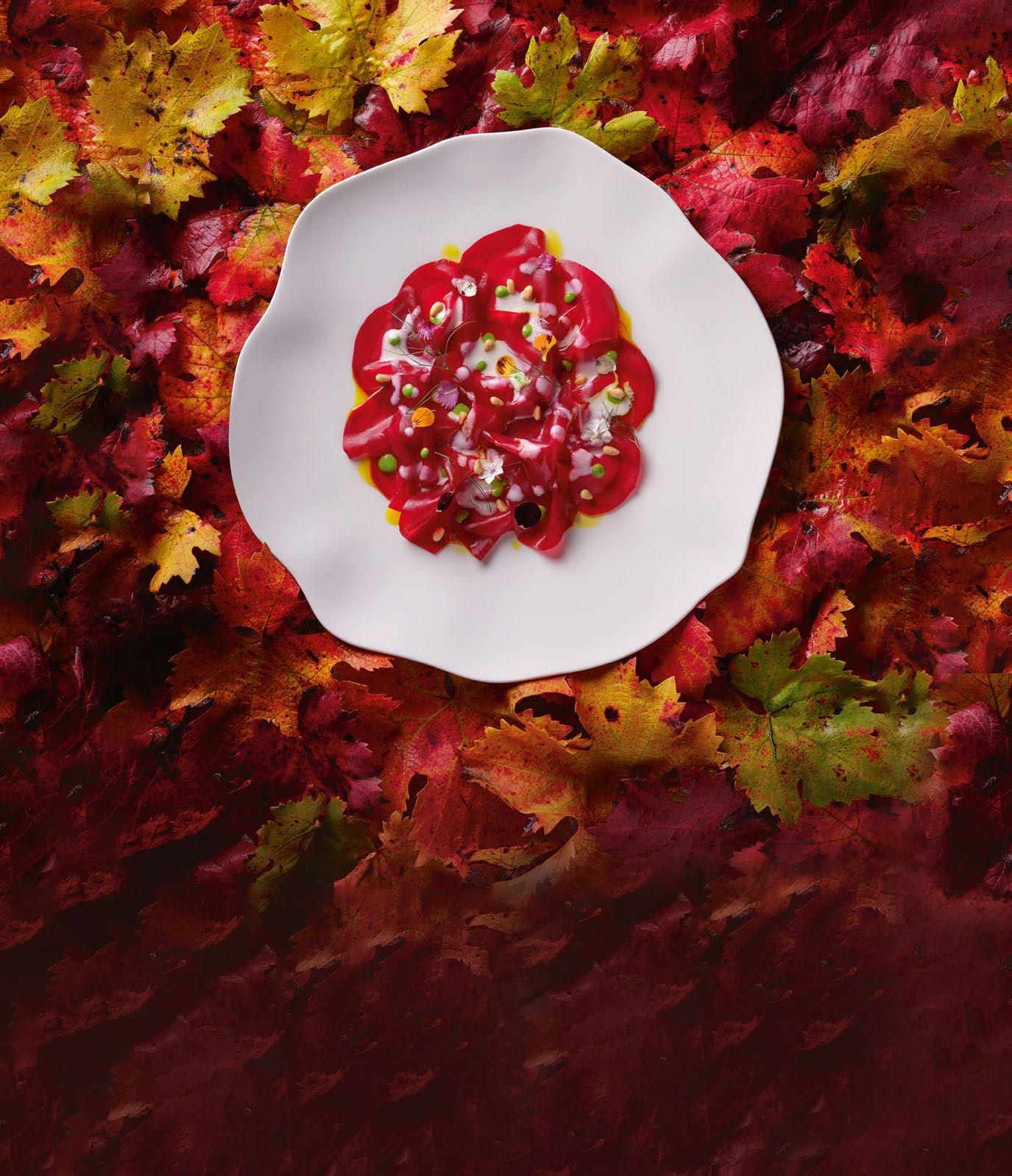
As longer nights draw in across Italy’s EmiliaRomagna region, diners at the newly-renovated luxury bed-and-breakfast Roncolo 1888’s gourmet restaurant La Limonaia can look forward to Chef Mario Comitale’s signature Red Veg Carpaccio returning to the menu. The dish embodies the culinary star’s philosophy of exploring modern Emilian cuisine via the raw, seasonal produce offered by the province itself, respecting tradition while also catering to vegetarian and vegan diners.
The protagonist here is the red turnip, selected by Comitale for the way it showcases the colours and flavours of the natural world. It is enhanced with traditional local products such as toasted pine nuts, cream of Parmigiano Reggiano 60 months, saffron emulsion and dill,
while a few drops of the property’s very own Traditional Balsamic Vinegar of Reggio Emilia DOP (Gold) provide a just-sweet-enough finishing touch.
Comitale, who loves the way the flavours of the turnip interact with the other ingredients, chose the tuber in tribute to his previous culinary experience in Chianti, pairing it with Emilian ingredients to symbolise his new gastronomic territory. He selected the carpaccio cut for the way it releases the taste of the vegetable, as well as for its visual qualities.
“I love the earthy taste and the enveloping colour that evokes the time of year when we use it,” he explains. “Especially in the autumn season, it really visually represents the place where I work.”
SIGNATURE
La Limonaia Roncolo 1888
EMILIA-ROMAGNA
© Nadir Bonazzi

Decency and Decadence

Hailing from opposite sides of the world, Leo Robitschek, Vice President of F&B at Sydell Group, and Liana Oster, Head of Bars at NoMad London, have met in the middle in central London. The duo, who come from the US and Australia respectively, are responsible for conjuring up the beverage programme at NoMad’s flagship in the city’s Covent Garden neighbourhood – most recently at the property’s new bar. Common Decency, in the softly-lit basement of what used to be Bow Street Magistrates’ Court, has a sense of decadence and nostalgia that is very much in keeping with NoMad’s ethos of bespoke hospitality coupled with sensuous design and – above all – fun. Its entry exudes grandeur, something that hotel bars used to be known for, making the venue a much-appreciated addition to the ever-evolving London bar scene.
Robitschek grew up in Miami, in a family that embraced hospitality and culinary curiosity from an early age. “I always loved family
dinners; my parents made us gather around the dinner table every evening,” he says. “We would also go out but not to your typical kid-friendly places, more so to grown-up restaurants. We were allowed to order whatever we wanted as long as we finished the meal. So, I picked the most obscure things.” As a child, the future grand master of cocktails dreamed of living in New York; moving to the city offered him a blank canvas on which to paint an illustrious career in the drinking and dining sector.
As the lives of bartenders tend to go, Robitschek’s path featured many twists and turns – including studying for a postbaccalaureate pre-med programme – but eventually led him to the eminent Eleven Madison Park, which at the time was under the direction of restaurateur Danny Meyer. “He was the opposite of what many other places were doing at the time in New York; he treated his people with kindness and what he calls enlightened hospitality,” explains Robitschek. “However, there was no cocktail programme
Award-winning bartenders Leo Robitschek and Liana Oster discuss transplanting their innovative beverage philosophies from New York to London via NoMad’s newest watering hole.
Words: Heleri Rande • Photography: © Cristian Barnett

SIPPING
in place; there was a cocktail menu by necessity from 1998, but this was 2005. So, I started playing around, doing tastings. Everything I did was trial and error.”
His creativity was rewarded when Daniel Humm and Will Guidara took the reins of the venue, with an ambition to make Eleven Madison Park the best restaurant in the world. The duo wanted Robitschek on the ride with them. “I had a chef and a general manager who cared about cocktails,” he recalls. “This was revolutionary, as the chefs in other places did not appreciate that at all. I had a mentor in the kitchen world and access to an incredible pantry. Back then it was very different to the classic form of bartending.”
Fast forward to 2019, and Andrew Zobler of the heavy-hitting Sydell Group had recruited Robitschek to work on the opening of NoMad New York, a hotel where food and drink co-existed seamlessly. There, his work had an immediate and influential impact, with the venue and its team winning numerous industry awards, including Tales of the Cocktail’s Spirited

Awards and the James Beard Award for Outstanding Bar Program, in addition to placing fourth on the World’s 50 Best Bars, and being named Best Bar in North America twice – all between the years of 2013 to 2020. In 2021, the NoMad concept made its way across the Atlantic to the UK, with Robitschek very much at the helm of its F&B offering.
As fate would have it, Oster’s journey also took her to NoMad New York, during her very first month in the city following a move from Australia. But having learnt her craft at Bar Americano in Melbourne, the hostess trial she was offered at the hotel wasn’t exactly what she had in mind, so instead she answered a call for bartenders at the renowned watering hole Dante. “I came to New York wanting to be a bartender, so I took the opportunity at Dante which was fantastic,” she says. “I grew a lot personally and professionally in that role.” Under her leadership as Head Bartender, Dante was named World’s Best Bar by both Tales of the Cocktail’s Spirited Awards and the World’s 50 Best Bars list in the same year (2014).
But new horizons beckoned. “I always wanted to live in London, and hearing about the NoMad opening there, I spoke with Leo and his other team members and well, the rest is history,” she recalls. Though the pandemic threw the group multiple curveballs, eventually the doors opened, and just like that, a slice of New York was transported to the British capital.
“It was really important that we morphed the NoMad feel into its new surroundings; we are all about juxtapositions, be it lighting, music or the way we treat ingredients,” explains Oster.
The treating of ingredients is the lynchpin of the philosophy at Common Decency, which launched in September. Seasonality is practically a given these days in London’s gastronomic scene, but Robitschek
LEO ROBITSCHEK
090 SIPPING
“In many places in West London you need to be on your best behviour; in the East you need to be casual, oftentimes standing. At Common Decency you can do both.”

NYC Showroom, 41 Madison Ave. | (800)-351-9842 | info@orrefors.us | www.orrefors.us
LIANA OSTER

and Oster have taken it a step further here. “On the menu there are eight ingredients that represent the time and the season,” explains Robitschek. “We make each in two different ways – one more classic but done in the NoMad way, and the other is juxtaposed with a more conceptual idea. All the work is done behind the scenes using kitchen-centric techniques. That is why the flavour is not what you think it will be.”
For example, the cocktails Green Muse and Cool as a Cuke both centre around the humble cucumber, but while the first includes Pernod Absinthe, lime, Lillet Blanc, pickled cucumber, dill and club soda, the second iteration features Olmeca Altos Blanco, Mexican Sour by Two Tribes, coconut and lacto-fermented cucumber: a delightful dichotomy.
What was the reasoning behind their unconventional approach? “After the pandemic we want to drink differently; we want to drink well but we also want to have fun,” elaborates Robitschek. “In many places in West London you need to be on your best behaviour; in the East you need to be casual, oftentimes standing. At Common Decency you can do both, depending on your mood.”

The creativity of the concept is matched by Common Decency’s culinary team: Executive Chef Ashley Abodeely, who oversees the kitchen at NoMad London, works closely with Robitschek and Oster to complement – but not lead – the bar experience. On the snacks menu are hot dogs with celery and black truffles, and bite-sized potato rosti topped with crème fraiche and caviar.
At hotel bars globally, a signature sense of grandeur has been given a modern makeover, with venues increasingly feeling less pretentious and more welcoming and inclusive. Common Decency goes above and beyond in that sense, artfully fusing the sophistication of West London and the playful ease of East London in the middle of the bustle of Covent Garden. Liberal, unorthodox and wholly international, it marks the ideal spot for this cosmopolitan meeting of creative minds.
092 SIPPING
“We are all about juxtapositions, be it lighting, music or the way we treat ingredients.”
…CELEBRATES THE ART OF FISH

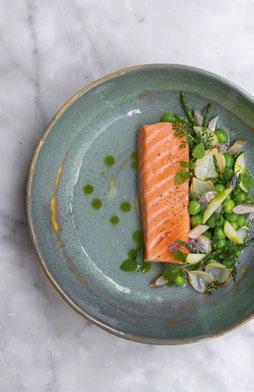


First fish to obtain the prestigious Label Rouge quality mark Farmed in the clear waters of the magical Scottish Highlands and Islands Guaranteed Quality and Origin
Full traceability from egg to plate
 Le photographe du dimanche –Pierre-Louis Viel & Valery Drouet
Le photographe du dimanche –Pierre-Louis Viel & Valery Drouet
WWW.SAUMONECOSSAIS.COM
LABEL ROUGE SCOTTISH SALMON
Summiting Mount Everest is an achievement reserved for those tenacious few prepared to dice with death and battle frostbite, altitude sickness and hypoxia in their bid to scale the earth’s highest peak. Happily, for the rest of us, there’s Sherpa: a stirring concoction that cleverly distills the most thrilling aspects of the extreme Himalayan mountaineering experience into cocktail form.
Sherpa is one of 16 creative libations on St James Bar’s new Once In A Lifetime menu, which was inspired by bucket list activities. It features a heady mix of Corte Vetusto Mezcal Espadín, Hennessy VS Cognac and Cynar together with Leonor Palo Cortado, Nectar Pedro Ximenez Sherry, mountain bitters and palo santo. The team use an ultrasonic bath to make a palo santo tincture using vodka as a base spirit, adding drops to the drink to inject woodiness and depth. The ingredients are combined in a mixing tin before being poured into a rock glass containing a large ice cube, and finished with a spray of Muyu Vetiver Gris.
“Climbing Mount Everest is quite a tough adventure,” concedes Head Bartender Angelo Sparvoli. “So is this drink: it’s complex, smoky, bold and spirit-forward. It is to be enjoyed slowly.”
Please hike responsibly.
 Sherpa St James Bar Sofitel St James LONDON
Sherpa St James Bar Sofitel St James LONDON
COCKTAIL
© Will Stanley
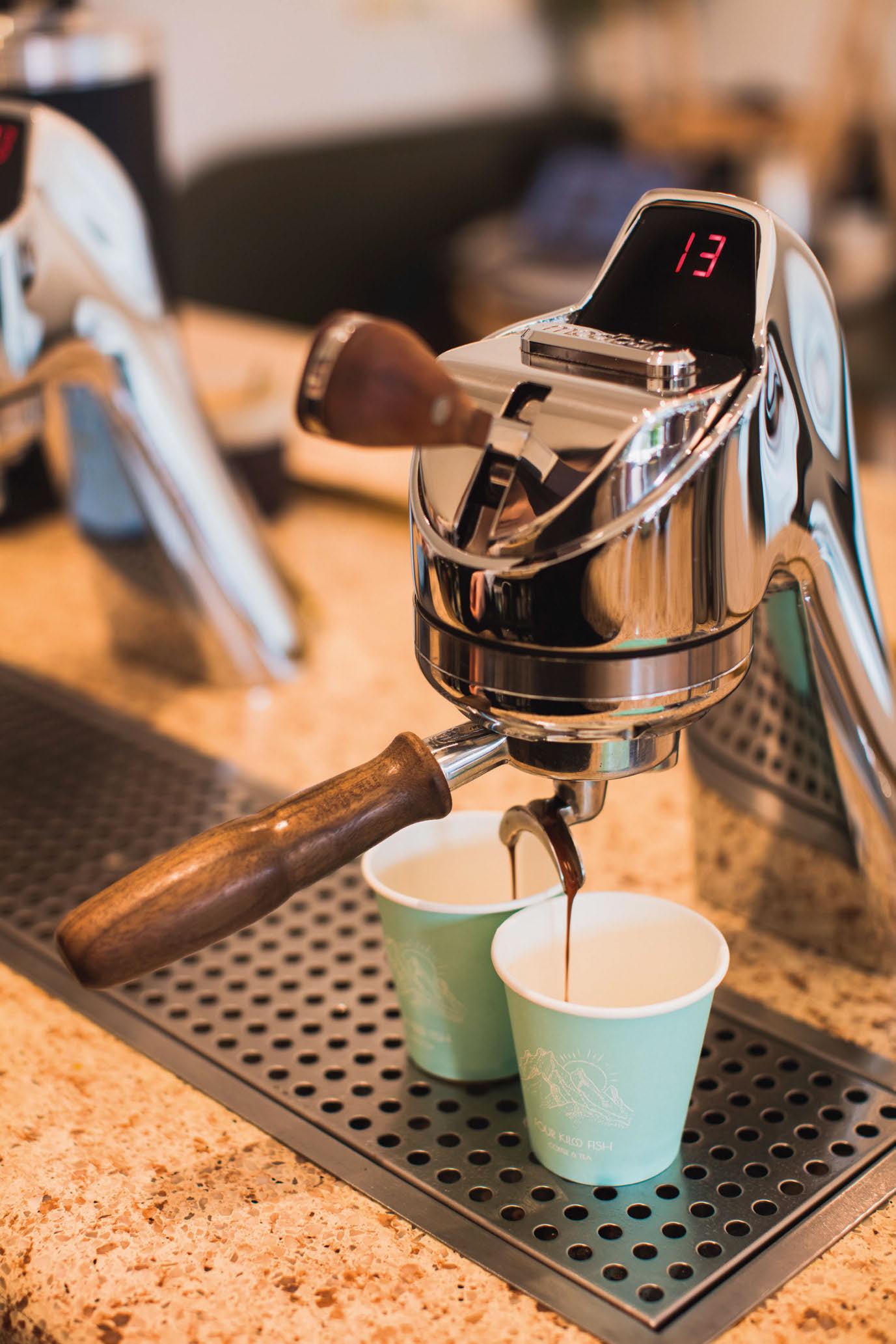 Invisible Rose Lola Rouge Naumi Wellington NEW ZEALAND
Invisible Rose Lola Rouge Naumi Wellington NEW ZEALAND
While the Northern Hemisphere braves out the last of its winter chill, New Zealand is enjoying balmy long evenings that practically beg to be enjoyed with a chilled drink. Luckily, tropical vibes are on the menu at the new boutique hotel Naumi Wellington, whose Lola Rouge bar and restaurant is already known for its curated list of summery signature cocktails; chief amongst them the Invisible Rose. Inspired by the city of Wellington’s famous botanical gardens, the drink features a sultry blend of rose-infused vodka and passion fruit together with pineapple juice, zingy lime juice and rose bitter, all laced with demerara syrup and passion fruit puree; the fruit also lends its flavour to the concoction’s crowning edible smoke bubble.
The ingredients are dry shaken before being combined with ice and poured into a simple clear coupe glass. “I recommend having more than three to four tasting notes in a single craft cocktail, as this helps to build different tastes on the palate,” says Head Bartender Oscar Ipac Jr. “This is an easy-todrink cocktail with a different taste profile, thanks to its unique ingredients, that builds up in the palate. You get sweet, sour and a bit of texture from the foam that the pineapple juice creates.” Sounds like the perfect summer romance.

COCKTAIL

Discover Oxido Emerald & Revive at www.fine2dine.com @fine2dine
DRINKS
Beefeater Crown Jewel
Inspired by the treasures housed in the Tower of London, Crown Jewel is a re-imagining of Beefeater’s signature house style, which is widely regarded as the pinnacle of the gin collection. Embodying London’s timeless spirit, the new tipple features the addition of refreshing grapefruit and a boldly heightened 50% strength resulting in a perfectly balanced gin, with clarity of flavour and unmistakable depth. Captured in a ruby bottle, the versatile liquid delivers an expression that is multi-faceted in its appearance and possibilities when served. On the nose, Crown Jewel offers a confident juniper and citrus aroma that is rounded and all encompassing. The palate is characterised by fresh grapefruit-led citrus at first, before a bolder kick of classic juniper forms at the crown. A long progression of warm spices and a hint of liquorice sweetness finish with a reminder of deeper citrus notes. The botanicals are carefully balanced to provide long, complex flavours that excite the palate through to the finish.
www.beefeater.co.uk














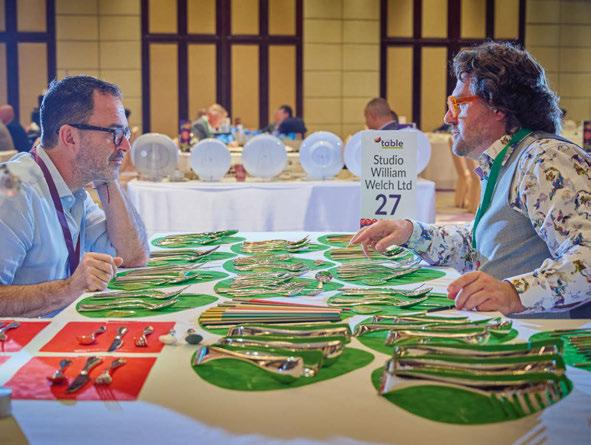
100
To The Table Asia
4-6 October 2022
BANGKOK
Tropical Bangkok provided the adventurous backdrop for the long-awaited return of hospitality forum To The Table to Asia.
Having waited patiently throughout the Covid-19 pandemic, hotel F&B professionals were eager for the chance to reconnect with industry colleagues and get back to business in Asia – and happily, the opportunity arrived in October, with the launch of the highly-anticipated To The Table Asia 2022 forum at Shangri-La Bangkok.
With a delegate list that read like who’s who of hospitality, the event saw strong support from influential returning buyers including Hilton Worldwide, Millennium Hotels & Resorts and Shangri-La Group, while key decision makers from prestigious hotel groups including Anantara, Six Senses, Radisson Hotel Group and The Standard attended for the first time. Returning suppliers included Villeroy & Boch and Steelite International, while Dibbern, Drinique, La Tavola and Modbar/La Marzocco were among those making their debut.
While the main draw for many attendees was the extensive roster of one-to-one meetings between top suppliers and decision-makers operating in Asia’s hotel F&B sector, a trio of evening events allowed for more informal networking, while a seminar programme chaired by F&B writer Devina Divecha offered the chance to weigh in on the issues currently dominating Asia’s hospitality scene.
After a successful welcome drinks function on the first night, things got underway on the morning of 5 October with a seminar entitled The Culinary Perspective. Raheel Ahmad (Culinary Director APEC, Marriott International), Franco Brodini (Regional Executive Chef, Southeast Asia and Australasia, Shangri-La Group) and Kevin Fawkes (Culinary and F&B Director, Anantara Hotels, Resorts and
Spas) discussed emerging trends and best practices in terms of cutting down on waste, optimising menus and handling the rising price of both food and labour. “Concern about wellbeing, concern about health; these things have taken on a new dimension,” said Ahmad, referring to the transition to the post-pandemic era.
Sustainability and the Restaurant of the Future was the topic of the second seminar, which saw Nigel Moore (Vice President Food & Beverage, Luxury Brands, South East Asia, Accor), Jonathan Heath (Corporate Food & Beverage Director, Six Senses Hotels Resorts Spas) and Alan Barr (Founder, Greymatters) explore the role that design has to play in improving the industry’s green credentials.
Consumer trends were on the agenda the following morning, with Rohit Sachdev (CEO, Soho Hospitality) unpacking the concept of Redefining Luxury Dining in the Post-Covid World. He touched on the importance of authenticity in the current landscape, pointing out: “People want something that is genuine and real; the pandemic has accelerated the experience trend.”
Looking ahead, the final seminar of Technology and the Future Guest Experience examined opportunities to use data to boost guest engagement. Ira Vouk (Founder, Author and Principal, Hospitality 2.0 Consulting) and Konstantinos Desis (Vice President, Customer Technology Services, SE Asia, Japan and South Korea, Accor) offered up their thoughts on how tech is shaping restaurant interactions.
Before long it was time to head to the airport, deals signed; although for a cohort of delegates attending To The Table’s Europe forum, the reunion was almost imminent.
EVENTS 101
Words: Shanna McGoldrick • Photography: © Richard Pereira
To The Table Europe
And so to Malta, for To The Table’s final event of the year: a meeting of minds for suppliers and decision-makers focused on the European hospitality market. The backdrop to was provided by Hilton Malta, a Mediterranean getaway located in the charming seaside enclave of St Julian’s.
As anticipated, the guest list comprised influential professionals from the continent’s F&B sector, with continued support from heavy-hitting buyers such as Accor, Belmond and Marriott International to name just a few. Several, such as Edyn, Hilton Worldwide and NH Hotel Group, were attending for the first time.
Editor Heleri Rande addressed a range of topical regional hospitality issues.
Words: Shanna McGoldrick Photography: © Richard Pereira
On the supplier side, Pernod Ricard was among the many high-profile returnees, while Mapal Group and Mikks made their first appearance.
Over the course of an energising three-day programme of focused one-to-one meetings interspersed with industry seminars and convivial networking dinners, the delegates got down to business. Four seminars chaired by hospitality strategist and Supper Consulting
Dubbed Elevating the Restaurant Experience, the opening seminar explored ways to develop ‘wow factor’ culinary narratives. The speakers – Anthony Worrall (Senior Director F&B Europe – Development Openings and Operations, Hilton Worldwide), Jordan Kiziuk (Head of Experience, Edyn) and David Martin (Global Head of Restaurants & Bars, Corinthia Hotels), opened up about current industry trends and innovations. While Kiziuk emphasised the significance of F&B concepts serving the wider neighbourhood beyond the boundaries of the hotel, Martin pointed out the rapidly increasing need to both appeal and cater to an upcoming generation of guests that use social media for inspiration, and as a booking tool. The dangers of over-programming were also discussed, as Kiziuk spoke about looking at a hotel’s assets from a multi-dimensional perspective and taking the time to consider alternative, nonF&B experience activations if appropriate,

102
21-23 November 2022
MALTA
What better way to round out 2022 than by doing business in the balmy Mediterranean surrounds of Malta?
saying: “If you can weave in some degree of gamification and playfulness into a concept, it’s a winning formula.” Worrall pointed out the importance for hotels to “hold their nerve” while waiting for F&B venues to establish themselves, rather than jumping in too quickly to tweak and potentially overcomplicate things. As Martin concluded: “There’s a very thin line between trying to be overly-ambitious and overprogramming, but also not doing enough; not having enough appeal or doing something that is exciting.”
These observations fed neatly into the next seminar, Taking Restaurant Design to the Next Level, which saw Afroditi Krassa (Founder, Afroditi Studio) and Rutger Van Erp (Vice President of Design & Construction, Odyssey Hotel Group) share their views on the role of design trends in meeting the needs of modern diners. Here, the question of authenticity at all costs arose, with the duo exploring the need for a balanced approach in today’s globalised market. Krassa pointed out that trying too hard to appear
authentic might occasionally be detrimental to a project, saying: “Hotel operators forget that they live in their own ecosystem, so what is important is to think ‘what’s happening in town, and how can I create something that’s unique and competitive in the local market?’” Sustainable Strategies for a Changing Landscape was the topic of the third seminar. Philip Halanen (Head of Sourcing and Sustainability EMEA, Wyndham Hotels & Resorts) and Emily McLeish (Head of Communications, Sustainable Hospitality Alliance) tackled the subject with aplomb, talking about the importance of transparent, shareable resources and frameworks within the industry that allow both hotel operators and suppliers alike to align with environmentally forward-thinking strategies and measure their progress along the way. Halanen underlined the importance of data in driving sustainability, while McLeish highlighted the non-profit alliance’s newly launched Pathway to Net Positive Hospitality framework.
The fourth and final seminar played to a full house, with Boris Simm (Group Vice President Operations Ruby Group), Ben Bengougam (Senior Vice President Human Resources EMEA, Hilton International) and Dusti Guzman (Executive Vice President / Chief Human Resources Officer, Sortis Holdings) convening to discuss Inspiring Passion within Hospitality. From profit sharing programmes and longevity bonuses to free tattoos, the trio explored the various initiatives their companies have implemented to attract, retain and inspire staff. Improving work-life balance for female chefs was a topic Bengougam touched upon, saying: “We’re very seriously motivated at all levels of the organisation to drive diversity.”
One last afternoon of high-level meetings and a lively goodbye dinner later, and To The Table Europe was a wrap.


The next To The Table will take place in Abu Dhabi from 6-8 March 2023. www.tothetablemea.com


EVENTS 103
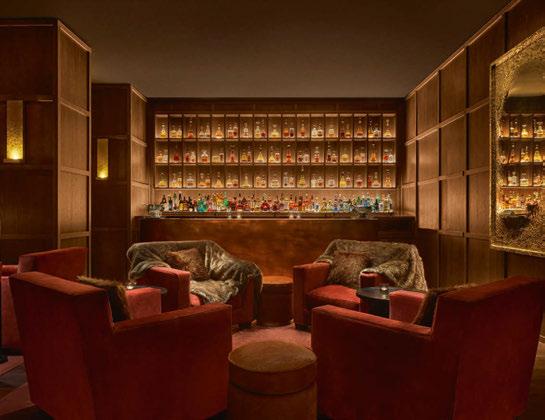



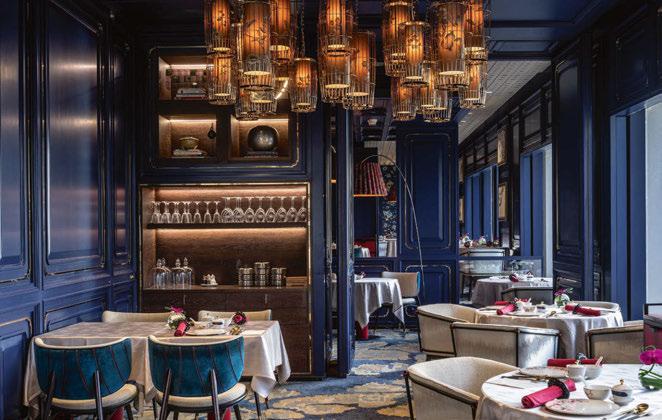

104
Clockwise from top left: Punch Room at The Madrid Edition; Leon at The Dubai Edition; Dowling’s at The Carlyle, New York; The Aubrey at Mandarin Oriental Hyde Park; Bushra at Grosvenor House; Man Wah at Mandarin Oriental Hong Kong
AHEAD: Winners Announced
From a speakeasy-inspired lounge in Dubai to an Upper East Side supper club, this year’s AHEAD winners represent the most outstanding hotel F&B spaces around the world.
Words: Eleanor Howard
Whether a buzzy bar or a refined restaurant, F&B spaces are widely regarded as the beating heart of any hotel. As such, AHEAD – the Awards for Hospitality Experience and Design –recognises their importance, with categories in each regional scheme dedicated to Bar, Club or Lounge as well as Restaurant. Following awards ceremonies in Singapore, New York, Dubai and London, the winners have now been announced.
MANDARIN ORIENTAL TRIUMPHS IN ASIA
Designed by Silverfox Studios, The Aubrey at Mandarin Oriental Hong Kong emerged victorious in the Bar, Club or Lounge category at AHEAD Asia. Offering views of Victoria Harbour, the all-day drinks and dining space was described by the judges as “an exceptional entry that has real personality, sense of place and nuanced touches”. The panel also applauded the Singapore-based firm for “delicately illustrating a strong East-meets-West narrative that is well-aligned with the Mandarin Oriental brand”. Demonstrating Silverfox Studios’ hotel F&B design expertise, the company went on to scoop a second award for its work on the same hotel’s signature restaurant Man Wah, characterised by timber panels finished in a deep blue lacquer. Judges praised the heritagemeets-contemporary concept, stating: “This is a thoughtful design that respects the history of the restaurant with a new modern take on luxury Chinese dining.”
NEW YORK REIGNS SUPREME IN AMERICAS
In the Americas, the Big Apple’s F&B venues struck a chord with the judges; particularly the recently renovated Dowling’s at The Carlyle –which won best Restaurant – and newcomer Nearly Ninth at Arlo Midtown, which was named best Bar, Club or Lounge. “A visual feast peppered with rich detailing” in the words of the judges, Tonychi Studio’s scheme at Dowling’s was lauded for injecting new life into the beloved Upper East Side haunt, adopting a sleek supper club aesthetic that marks “a step back into history seen through a fresh lens”. Gerber Group and Meyer Davis’ collaboration at Arlo Midtown, meanwhile, produced a “layered materiality” that resonated with the panel, who described the result as “beautifully balanced, calming and inviting”.
MARRIOTT SWEEPS THE BOARD IN MEA
LW Design fared well at AHEAD MEA, with the Dubai-based studio winning both F&B awards. The speakeasy-inspired Leon at The Dubai Edition claimed the Bar, Club or Lounge prize, with the panel praising the venue for its as “sophisticated restrained palette of materials that will age better with time, just as a speakeasy should”. Another judge commented that “the scale and intimacy adds to the guest experience and intrigue, and the tones and colours add eclecticism”. Proving the success of LW Design’s relationship with Marriott International,
Middle Eastern eatery Bushra by Buddha-Bar at Grosvenor House, A Luxury Collection Hotel, wowed in the Restaurant category. One judge recognised the “attention to detail and colour accents that break up the neutral tones”, while another stated that everything from the styling and arrangement to the menu feels completely aligned for a cohesive concept.
SULTRY SCHEMES SUCCEED IN EUROPE
Concluding the awards season with the flagship event in London, AHEAD Europe saw luxury and lifestyle hotels win big. “This will be a space that stays in my memory having enlivened the senses” were the words of one judge when praising Punch Room at The Madrid Edition, a contemporary reimagining of the brand’s signature bar. Described as “bold, brave and incredibly atmospheric” the panel attributed the venue’s success to its ability to build anticipation. Over in London meanwhile, Mandarin Oriental was successful in the Restaurant category with The Aubrey’s Hyde Park outpost. Judges praised London-based interior design studio Brady Williams for its “exquisite use of materials and detailing”, declaring the Japanese izakaya “a lesson in seductive design”.
Entries for AHEAD 2023 open on 25 January for all four regions. For further updates, follow on social media at @AHEAD_awards or visit: www.aheadawards.com
EVENTS 105



PETITS FOURS
Essence is a stylish porcelain series designed by Rene Ozorio. With a wide selection of rimmed presentation and banquet plates, coupes, trays and bowls, this collection exudes both a modern and classic look. A return to basics with a white, pure aesthetic, its elegant profile is enhanced by a body and glaze infusion that leads to a durable product, ideal for high volume banqueting. Steelite’s philosophy of creating special and memorable dining experiences that expertly complement the creativity of the chefs is embodied in the series: Rene Ozorio masters the art of presentation, shape and design that breaks the norm of traditional tabletop settings. www.steelite.com
 Steelite International Rene Ozorio Essence
Steelite International Rene Ozorio Essence
1. Amefa Soprano
Amefa’s Soprano collection celebrates cutlery with a clean design that stands out for its modernity and slim lines. Made from high-quality stainless steel with a black PVD finish on the handles, the series brings a contemporary look to the table, combining elegance and style with a statement design that enhances the eating experience. Heritage brand Amefa has been setting tables all over the world ever since it was founded back in 1931, and the family-owned business’ origins are rooted in the hospitality industry. The company offers a diverse range of flatware and kitchen products, spanning designs created to suit a variety of styles and occasions. www.amefa.com

2. Vista Alegre Hotelware Texture

As its name suggests, this series of Vista Alegre plates designed by the Dutch tableware specialist Mieke Cuppen puts an emphasis on the importance of texture. The striking, design-forward collection offers multiple opportunities to play around with plating, thanks to a surface that influences how and where food is placed. The transition from a soft glazed texture to one that is unglazed makes for an alluring effect, while the interactions and contrasts between other pieces and materials add to the impact. Portuguese heritage brand Vista Alegre operates in tableware, decorative porcelain pieces, hotelware and chinaware, among other areas. hotelware.vistaalegre.com
3. Fine2Dine Dune
Dune combines intense warm sandcoloured notes with either a deep ocean blue or blush pink reactive glaze that is designed to softly immitate a gust of wind crossing over the dunes. Created with the most joyful of gatherings in mind, the collection features elegantly rounded borders that contrast stylishly with its robust and strong shapes. This high quality porcelain tableware range promises to provide an eye-catching dining experience suitable for a variety of hospitality environments. Fine2Dine stands for trend-based, high-quality tableware for creative professionals, providing solutions for hotels and restaurants all over the world. www.fine2dine.com


4. Villeroy & Boch Château Septfontaines
In 2023, Villeroy & Boch is celebrating its 275th anniversary. Since 1748, it has been synonymous with sophisticated aesthetics and innovative ideas and technologies for everything to do with ceramics. Its new signature collection Château Septfontaines – named after the Luxembourg residence built for the Boch brothers in the 18th century – unites everything that has defined the company: heritage and modernity, tradition and ingenuity. The series was inspired by the company archives: classic style elements have been adapted with great delicacy and love of detail and carried over to a modern, contemporary aesthetic in the Art Deco style.
www.villeroyboch.com/hospitality
108
1.
2. 3. 4.
1.
2.
1. Serax
Nido by Ann Van Hoey
Ann Van Hoey has been designing bone china tableware for Serax for over a decade, and the design process for her Nido collection started with the mathematical approach that has come to define her style over the years. After using computer technology to generate the 3D models to make her moulds, she became so fascinated by the drawing programme’s construction lines that she decided to make use of them to develop various patterns. Using very fine porcelain fired at high temperatures allows for complex shapes and structures to be made, while its translucency renders the pattern highly effective. Pieces are finished either with a translucent glaze or a jade-green celadon.

2. Nude Glass Round Up
Round Up is a decorative, vintage inspired four-piece stemware range. The handmade lead-free glasses feature a rounded bowl to encourage smooth pouring and capture aromas, while the wide ribbed, optic surface accentuates the colour of the drinks within, lending each piece a festive quality. The elegant collection features four glass sizes: a broad red wine glass with a wide rim inspired by classic silhouettes, a more compact white wine version that is designed to optimise and preserve floral notes, a champagne coupe with a retrostyle twist, and a classic champagne flute made to emphasise various sparkling wine flavours. eu.nudeglass.com

3. Craster Juice Dispenser
The Craster Juice Dispenser is an elegant, spill-free solution designed to highlight tabletop service or buffet presentations. Part of UK-based brand’s versatile Tilt Range, it features an innovative ice-free cooling system that keeps eight litres of liquid cool for up to four hours. The simplicity of the product lies in the discretionary use of Craster Tilt Frames, which are made from stainless, brasscoated or black powder-coated steel and offer added elevation, enabling easy access for users, while also providing an appealing drink display. Drip trays can be easily placed onto the Tilt frame for enhanced stability and reduced spills to create a seamless serving experience. www.craster.com

PETITS FOURS 109
The porcelain tableware is complemented by four simple glasses that share the same shapes as the cups, as well as wooden presentation trays in walnut, inspired by Japan, featuring small feet that give the tray the impression of floating. With Nido, Van Hoey has designed a playful, contemporary series in the tradition of high quality bone china tableware that combines different patterns that fit together to form a beautiful whole. The collection will be shown to the general public exclusively in Belgium for the first time at the reopening of La Réserve in Spring 2023, before being presented in Belgian stores. www.serax.com 3.
1. Utopia Tableware
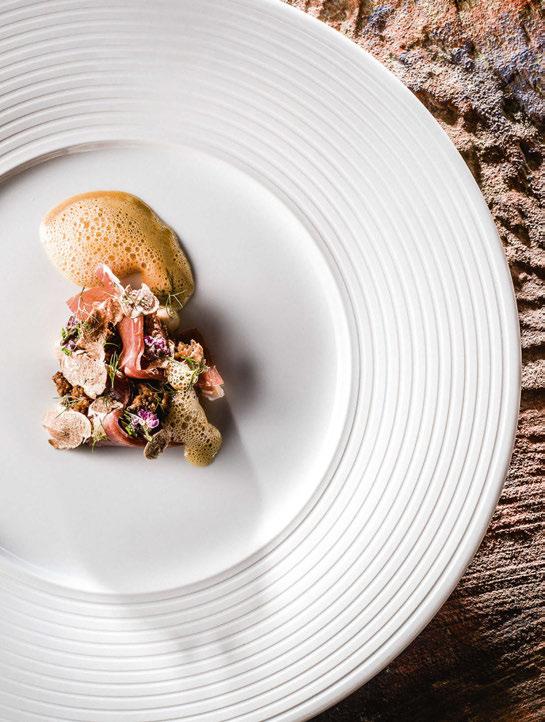
Enigma
Enigma is a standout new collection from Utopia’s 2023 launch. Ideal for supper settings, the series features a distinct reactive glaze that lends a variation to the finished effect, providing each individual piece with a truly individual look. Thanks to a softly blended mix of deep greys and browns, the collection walks the line between being warm and cosy while remaining boldly stylish. Made from vitrified porcelain, it includes two deep irregular bowls, three plates and a side cup suitable for food or drink. All pieces are dishwasher safe. Whether Enigma tableware is displaying a chef’s creations or waiting to be loaded from serving dishes, it makes a statement.
www.utopia-tableware.com

2. Raynaud Italian Renaissance
For more than a century, Raynaud has created porcelain with elegance and generosity as its governing principles. Manufactured in the UK since 1877, its signature Lincrusta material has its origins in the era of Italian Renaissance design: known for its opulent embossing, it is rich in its relief and delicate arabesques, and has found its echo in fine Raynaud Limoges white porcelain. The Italian Renaissance collection – which plays on poetic and sensual design accents in an ode to femininity – is the result of meticulous handiwork carried out on plaster in Raynaud’s workshops, where the distinct vegetal motif is sculpted, engraved and tamed.
www.raynaud.fr
3. Goodfellow & Goodfellow Hering Berlin Pulse Plate
At London-based Goodfellow & Goodfellow, the focus is on proposing increasing numbers of concepts based on luxurious white hues, leaning on the beauty and distinction such tableware offers. Enter the Hering Berlin Pulse Plate – an apt example of the ways in which great design and quality can be combined to dramatic effect. Developed to be incorporated or layered with the Hering Berlin Velvet or Cielo plates and bowls, the company can also create unique and inspiring concept solutions for any menu. Additionally, the range can be combined with other Hering Berlin options such as Obsidian and Silent Gold.

Founded by husband-and-wife team Paul and Valda Goodfellow, the creative company provides design-focused solutions for hotels, restaurants and contract caterers, with the London showroom displaying ranges from the world’s finest ceramics and glassware brands, including Hering Berlin and Narumi. Goodfellow & Goodfellow often collaborates with Michelin-starred chefs, leading restaurateurs, hoteliers and designers to supply branded tableware, kitchen equipment and chef apparel to establishments internationally. It also develops bespoke tableware solutions as part of its Design & Fulfilment service offered to operators and F&B professionals.
www.goodf.co.uk
110
3. 2. 1.
1.
3. 2.
1. Hepp Aves
With its dynamic lines, the design of Hepp’s cutlery collection Aves is based on the contours of a bird’s wing. This strong, streamlined appearance is applied consistently throughout the 19-piece series. The striking shapes include forks with an unusual tines to handle ratio, while the table fork and spoon stand out thanks to a material thickness of 9mm. Aves is available in polished stainless steel and various additional finishings on request. Options span PVD-coated or glass bead blasted finishes, as well as stonewashed, brushed or a combination of both, making Aves a flexible solution for a variety of hospitality solutions. www.hepp.de


2. Porland Re-Gen
Turkish heritage brand Porland’s Re-Gen series is brought to life through the process of recycling porcelain shards. Since 2005, the company has been offsetting its carbon footprint and its recycled production has seen great success. In 2022, its R&D strategy took another leap forward to complete the cycle of ‘no production waste’. Tons of broken pieces of kilned porcelain, misfits and non-standard choices are now being returned to the production cycle, to become the Porland Re-Gen line. Porland has been operating since 1976, and currently produces around 70 million units per year in its production facilities.
www.porland.com
3. Orrefors Nobel
Gunnar Cyrén is widely known for being one of the great designers of Swedish glass history: in 1991, he created the Nobel collection, which is still used at the annual Nobel Banquet in Stockholm City Hall every year. The prestigious event sees award winners from different countries in the world convene to celebrate with more than 1,000 guests – including members of the Swedish royal family, politicians, scientists, and artists. The collection is mouth-blown in Sweden and handpainted with details in real 22-carat gold and includes a wine/beer glass, a champagne glass, a martini glass and a decanter. Today, the Nobel collection is a highly coveted collector’s item, both in Sweden and around the world.
Heritage brand Orrefors has been producing glassware since 1898, and the brand’s skilled glassworkers collaborate with Sweden’s most prestigious designers at its glassworks in Kosta. A smaller element of the company’s production is also made in Europe and Asia, with each site following the same designers and, in many cases, the techniques developed in Småland, Sweden. In 1914 Orrefors started manufacturing crystal products, and the glass the brand produces today is based on expertise generated over more than a century.
www.orrefors.us

PETITS FOURS 111
2.
1. MyGlassStudio
Mid-Century Modern
The Mid-Century Modern canape display is a collection of bowl risers, tiered canape trays, footed boards and tasting plates for buffets and receptions. Made for professional use, the products are dishwasher safe, ultra-durable and hygienic. The glass surfaces are nonporous and metals are powder coated with an anti-slip rubber coating, while the colours are acid resistant and nontoxic. The collection comes in six colour themes: cream white and grey, beach glass, grey metallics, black and gold, white and gold and olive grey – with the option of bespoke design from 150 alternative hues.


myglassstudio.com
2. Costa Nova Festa
Combining ecologically sustainable methodologies with the one-use forms of the past is Festa, the environmentally focused collection from leading Portuguese brand Costa Nova. Composed from Ecogres, a proprietary composition of clay and recycled materials, the essence of this series highlights the ingenuity behind its design, as well as its ability to be used in endless combinations that are ideal for a range of food presentation scenarios. Fusing the environment and reusable tableware, this striking collection aims to showcase the beauty of the earth. Costa Nova specialises in durable, timeless fine stoneware products. www.costanova.com
3. Zieher Falcon
The Falcon etagere by Zieher was inspired by the elegance of the bird it is named after, giving wings to creativity at the buffet. A statement design piece that is bound to act as a talking point among guests, a single Falcon unit is capable of bearing up to three plates on its wings or, when used as a duo, holding full buffet platters. A combination of both can be installed for bespoke solutions that suit various situations. Anti-slip supports can be added on if necessary, keeping the positioning of the platters safe and stable and making the design suitable for use on all surfaces.

As a high-tea stand, the etagere carries plain white coupe plates or matte black plates with a slate-like structure, both of which fit exactly into the slots of the wings. The mirror-polished, solid stainless 3mm steel punctuates the fluidity of the dynamic shape, resulting in a majestic creature sitting on a stylised branch, which also provides a firm stand. Incorporated handrails also help to facilitate the service. Zieher is a name synonymous with innovative design, both in the tabletop and in the buffet section, and the brand counts five-star hotels and top class restaurants across more than 90 countries among its international client list, specialising in creative gastronomy trends and solutions.
www.zieher.com
112
3.
1.
2.
1. Heart & Soul Perfect Match
Heart & Soul collection, a new brand from the established BHS Tableware, is sure to inspire diners with its stylish and charming aesthetic. Offering on-trend chinaware for the food service industry with a unique look and feel, Heart & Soul focuses on vitrified china for vibrant table settings, with pieces catering to various food styles, from regional to fine dining. Its Perfect Match collection utilises reactive glazes to produce bespoke, unusual effects and handcrafted one-of-akind items. The series spans 25 different dishes in a total of five combinable colours, meaning it can be configured and adapted to meet the requirements of a variety of hospitality situations.
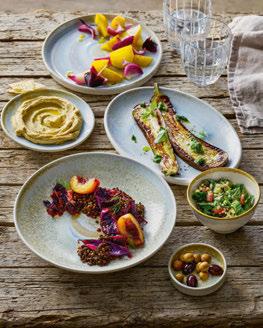
www.heartandsoul-tableware.com

2. Eternum Cutlery

Eternum is a Belgian cutlery brand headquartered in the city of Gembloux, Belgium. In 2024 the company celebrates its centennial anniversary, marking 100 years as an influential brand in the design sector. Its core business has always been the creation and sales of cutlery and table accessories, with the international hospitality industry a major focus area over the last several years. Today, Eternum exports its products to more than 70 countries globally, distinguishing itself through its innovative and striking patterns in the world of cutlery. It enjoys a reputation across the business for customer satisfaction, excellent service and honest pricing.
www.eternum.com
3. Franke Coffee Systems

Franke A1000
The A1000 is a premium coffee solution designed to provide moments of luxury. Combining Franke’s professional expertise and innovative spirit, the machine features a fully automatic CleanMaster system and an iQFlow technology that guarantees consistent in-cup quality using a range of predefined settings. FoamMaster creates smooth foam, while the Flavour Station allows users to select from a range of up to six on-trend syrup flavours to satisfy everchanging customer expectations. The A1000 is a universal solution that can be used in both in-served and self-service areas, and comes with the option to set up various payment methods. coffee.franke.com
4. Bonna Ground
With its new collection Ground, produced from recycled waste mud, Turkish porcelain behemoth Bonna (the horeca brand of Karl Porselen) presents its respect for the earth and its repetitive refrains that have surrounded humanity with compassion since the beginning of time. The aim of the simple, pared-down 10-piece series is to give back what has been taken from the soil. The collection consists of two different colours, the outer surface of which is a raw body, while the inner surface is grey and transparent. Even the boxes used in the collection’s packaging are made from recyclable materials, underlining Ground’s sustainable ethos.
www.bonna.com.tr
PETITS FOURS 113
4. 3. 1.
1. 2.
1. Costa Verde Terra
Costa Verde’s new porcelain collection Terra is one of its most meaningful yet. The series, the result of a creative collaboration with the US-based engineer and sculptural designer Pere Gifre, focuses on the elemental, symbolising the start of a new era for the Portuguese heritage brand. The line’s organic shapes and striking profiles combine to lend each piece an earth-carved appearance and a compelling, elemental aesthetic. Described as ‘a collection aiming to awaken the senses’, the series offers users a tactile experience that aims to connect diners with nature, thanks to its various rough and satin textures and different gradients.

pro.costa-verde.com
2. Cosy & Trendy Atlantis
The Atlantis collection from Belgian brand Cosy & Trendy is a series of two halves: the Stripe motif and the Circle pattern. Both designs draw the eye to the centre of the board, using deep blue colourways for visual impact with the added interactive element of a subtle, just perceptible texture. The variations in the series’ patterns lend an artisanal feel to the pieces, while the understated sides and dark edges bring a touch of tranquillity to the dinnerware. The Atlantis series comprises all the classic pieces required of a complete dinnerware set, with a large plate, deep plate, dessert plate, cup and saucer and a handy bowl all available.
www.cosy-trendy.eu
3.
3. Revol Bespoke Buffet


Far from being standardised, Revol offers a wealth of options for creating a buffet to suit the exact requirements of its diverse and international clients. This approach is encapsulated by the family-run luxury French heritage brand’s statement En Scène collection – which features everything from modern wired risers and natural wood essences to delicate ceramic finishes and patented translucent nacryl. A wide-ranging choice of multiple materials and the visual rhythms created by the architectural structure of the collection are examples of the ways in which the company aims to revolutionise buffet presentations in an elegant and stylish way. Revol, a ninth-generation family business based in the South of France, is a leading global manufacturer of professional kitchenware, tabletop and buffetware solutions that has been in operation since 1768. In recent years, the company has made a name for itself for the pioneering inroads it has made into sustainable production processes, becoming a leading manufacturer of 100% recycled ceramic paste tableware – a product line it continues to develop and expand. With a focus on experimentation and innovation, coupled with the expertise it has amassed over more than 250 years in operation, the brand remains at the forefront of the contemporary tableware industry.
www.revol1768.com
114 PETITS FOURS

1. Rona Linea Umana
Representing 125 years of glassmaking skill, leading Slovakian glass manufacturer Rona’s collaboration with the award-winning Italian sommelier Maurizio Dante Fillipi has resulted in a collection that ticks all the boxes when it comes to balancing functionality and sophisticated elegance. Fabricated using the brand’s pulled-stem technology, the ultra-light pieces feature a distinctive flared edge and smooth interior, which has been designed specifically to encourage the release of the drink’s aromas. The Linea range encompasses four wine glasses and two water glasses, each featuring the same soft and generous lines.
www.rona.glass
2. Corby Hall
Monaco Satin 18/10
Corby Hall, a family-owned business based in Randolph, New Jersey in the US, has supplied the international hospitality industry with high quality flatware, holloware and bright white porcelain dinnerware for more than four decades. Not only do its designs range from traditional to contemporary, but pieces are priced extremely competitively. Corby Hall has the ability to supply all food and beverage outlets associated with a fullservice foodservice operation, and the company’s global distribution network, coupled with its production facilities in Europe and Asia, facilitates a seamless service for both opening orders as well as for re-supply.
corbyhall.com
3. Modbar Modbar AV
Modbar, the original under-counter espresso machine, elevates the coffee service and preparation experience via its fine lines, customisable finishes and sleek interfaces. Its inimitable design means that solutions can be adapted to a variety of situations, while under-counter modules allow for easily programmable recipes, unmatchable technology, and easy access for technicians to service. The striking Espresso AV system is renowned for the quality of the espresso it produces, while the Modbar Espresso AV comes equipped with an adaptable drip tray, a multi-position programmable lever, auto-volumetrics and optional scales for extreme precision. www.modbar.com

4. Chef & Sommelier Reveal’Up

Reveal’Up is one of the eminent French brand Chef & Sommelier’s flagship collections for hospitality professionals, imposing its assertive style with elegance. Each item in the series is made with a high-performance, lead-free crystal glass material, Krysta, which is known for its lasting brilliance, shock resistance and transparency. Chef & Sommelier is the Glassware International Sommelier Association Partner, and the Reveal’Up stem glass has been selected for sommelier competitions worldwide several times, repeatedly winning over jurors and candidates for its three essential qualities: resistance, versatility and elegance. www.chefsommelier.com


116 PETITS FOURS
1. 3. 4. 2.

1. Huls Gallery Singapore Ban
The Ban tableware collection began life as a project to discover new products that represent Tokoname, a city with the longest history among Japan’s six ancient kilns. Artisans use a regionally sourced fine clay that is unique to the city, creating well-proportioned forms enhanced by a variety of colours achieved using a local glaze known as ‘chara’, which lends plates and bowls a tinge of gloss with a matte finish. Smooth to the touch, it is hardwearing and durable, remaining a practical choice for all environments. This distinct and elegant collection has captured the attention of chefs and restaurants, both in Japan and overseas.
huls.com.sg
2. Narumi Ramage
The concept of Ramage was inspired by a Narumi designer’s experience of Chinese and other East Asian gardens, as well as dreams of imaginary gardens in fictional nations. It features whimsical flowers designed in the image of chrysanthemums and peonies, which are native to China and popular in neighbouring Asian countries as well as Europe. Birds, said to bring happiness, and butterflies, representing new encounters, are depicted against a refreshing blue background, resulting in a poetic, artistic and optimistic collection that has been designed to suit various cuisines nurtured by the richness of Asian food culture.


www.narumi.co.jp
3. John Jenkins Glassware Professionals
John Jenkins is one of the UK’s leading designers and suppliers of crystal and glass for the high-end hospitality industry. Founded back in 1901, the brand’s principal aim is to design and supply stylish glassware that remains practical in service and complements both wine and table.
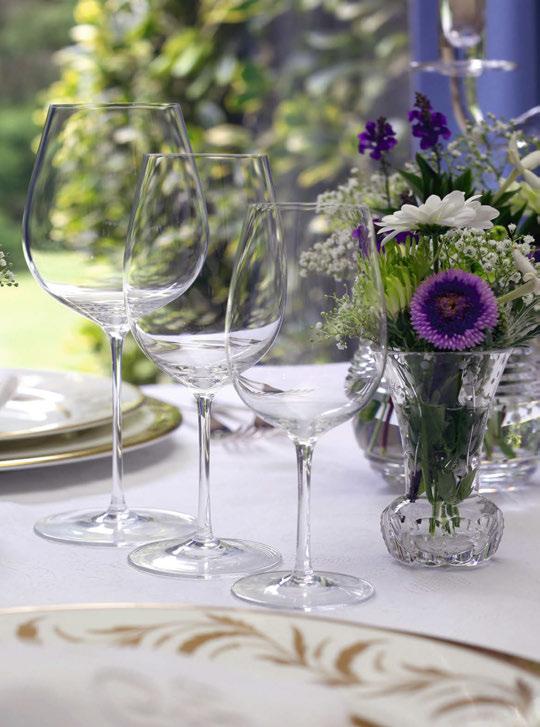
The company keeps in stock a diverse and expansive range of both handmade and machine-made glassware that runs the gamut from wine glasses and cocktail glasses to classic tumblers, all of which are available for immediate delivery. Its collections range from Gala to its finest wine glass series Starr, a fully handmade glass intended for the serious wine enthusiast. Its in-house design department also creates exclusive patterns of handmade glassware to suit the specific requirements of many of the company’s global hospitality client list, which includes luxury hotels, fine-dining restaurants and world-class bars.
The brand also has showrooms in New York and the US market is served by its distribution centre in New Jersey. Each pattern within its glassware portfolio benefits from the latest advances in glass making technology, which it implements diligently to enhance the clarity, durability and scratch-resistance of its glass.
www.johnjenkins.co.uk
118 PETITS FOURS
1.
3. 2.

#alltogether


The future will be what we build together.
ADVERTISING INDEX ISSUE 30
Amefa 048
Arc 043
BHS 025 Bonna 002
Corby Hall 123
Costa Nova 005
Costa Verde 033
Cosy & Trendy 061
Craster 115
Denby 020
Ercuis-Raynaud 059
Eternum 023
Fine Dining & Living 097
Franke 014-015
Goodfellows 019
HULS 073
Internorga 120
John Jenkins 083
La Marzocco Modbar 095
Monoware 085
MyGlassStudio 012-013
Narumi 106
Nude 117 Orrefors 091 Perrier-Jouët 006-007
Porland 010-011
Porser 047 Revol 081 Rona 067
Scottish Quality Salmon 093 Serax 039
Steelite 008-009 Stellar USP 016
To The Table Asia 119
To The Table MEA 087
Utopia 057
Villeroy & Boch 124
Vista Alegre 075
WMF 053 Zieher 045
121
Hungry for Adventure
Ramada’s new Chief Eats Officer might just have the best role in the business.
Ambitious foodies with a taste for adventure were left salivating at the recent news that Ramada by Wyndham was seeking a new CEO – that’s Chief Eats Officer.
The hotel brand, which counts properties in more than 63 countries, launched a global search for its new recruit back in October, with hundreds of applicants submitting videos demonstrating their appetite for the job. The company appointed the lucky individual to the position at the end of 2022.
The new CEO’s arduous responsibilities hinge on travelling the world to uncover cultural and culinary delights on behalf of the brand, documenting a curated list of must-eats on Ramada’s website and social media channels.
Over the course of three weeks this summer, they will visit up to eight different countries, recording
their adventures in real-time with unique photo, video and written content designed to inspire other travellers. The role also comes with some attractive perks: a US$10,000 reward, a $150 daily travel stipend, paid accommodations and air travel and an upgrade to Wyndham Rewards Diamond membership are all part of the package.
“Food is the key that opens the door to new cultures, which is what Ramada by Wyndham is all about, inspiring travellers while connecting them to new global experiences,” explains Stephanie Kendrick, Brand Leader and Vice President of Operations at Ramada by Wyndham. “Our CEO will have the chance to fully immerse themselves in the best Ramada and its many destinations have to offer, all while bringing along a global audience to share in every moment of their lifeenriching adventure.”

122
WASHING-UP
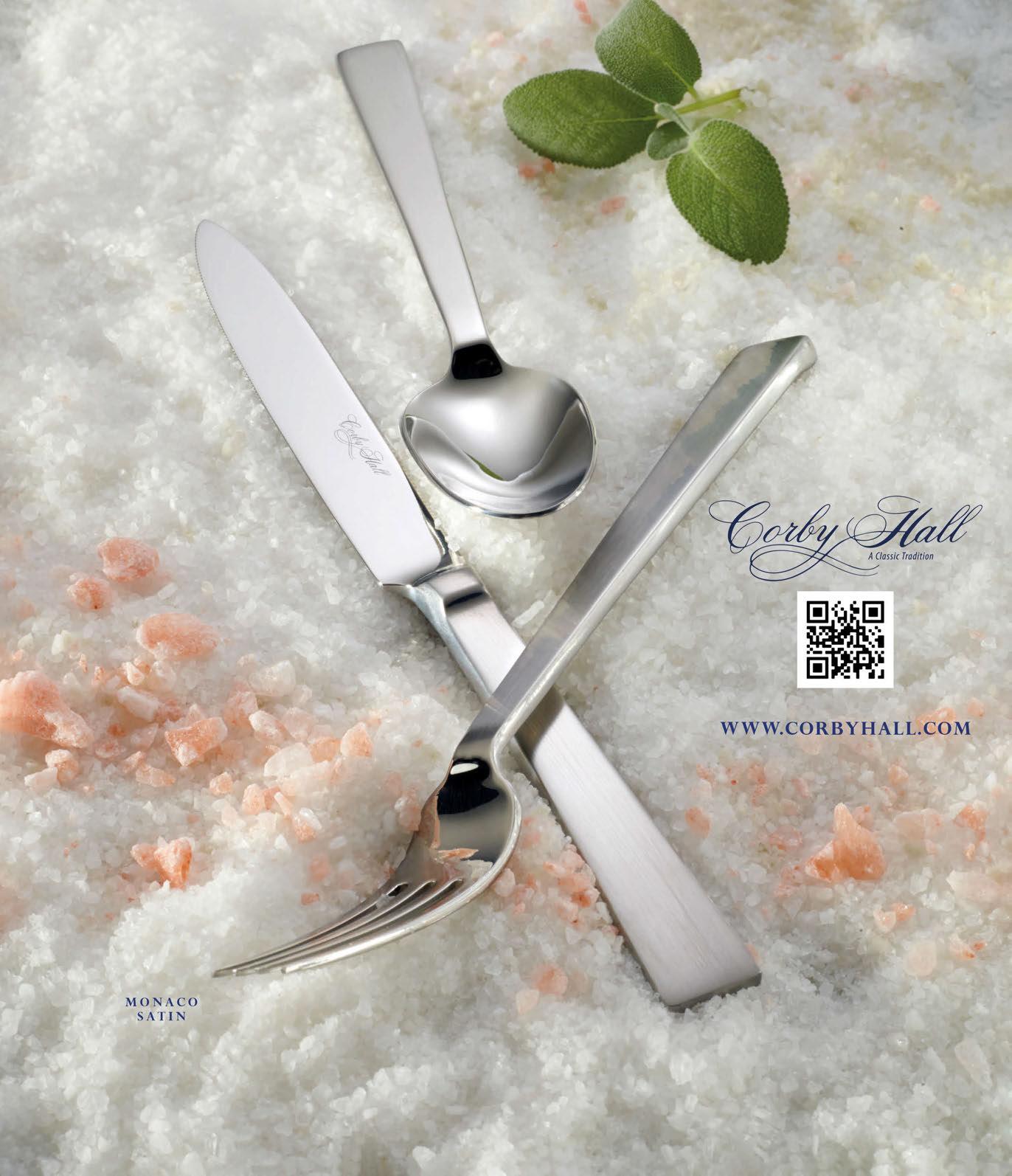
Creating

Hospitality Château Septfontaines – the elegant homage for extraordinary dining moments instagram.com/villeroyboch villeroyboch.com/hospitality facebook.com/villeroyandboch
 LEGACY – THE GRAND YORK • PACO RONCERO • DA VITTORIO – THE REVERIE SAIGON
LEGACY – THE GRAND YORK • PACO RONCERO • DA VITTORIO – THE REVERIE SAIGON





















 Stylelights by WMF Germany
Stylelights by WMF Germany














































 © Marco Bollinger
© Marco Bollinger










 © Paolo Chiodini
© Paolo Chiodini


 Words: Shanna McGoldrick
Words: Shanna McGoldrick










































 Words: Guy Dittrich Photography: © Edmund Dabney (unless otherwise stated)
Words: Guy Dittrich Photography: © Edmund Dabney (unless otherwise stated)














































 Le photographe du dimanche –Pierre-Louis Viel & Valery Drouet
Le photographe du dimanche –Pierre-Louis Viel & Valery Drouet
 Sherpa St James Bar Sofitel St James LONDON
Sherpa St James Bar Sofitel St James LONDON
 Invisible Rose Lola Rouge Naumi Wellington NEW ZEALAND
Invisible Rose Lola Rouge Naumi Wellington NEW ZEALAND































 Steelite International Rene Ozorio Essence
Steelite International Rene Ozorio Essence





















































